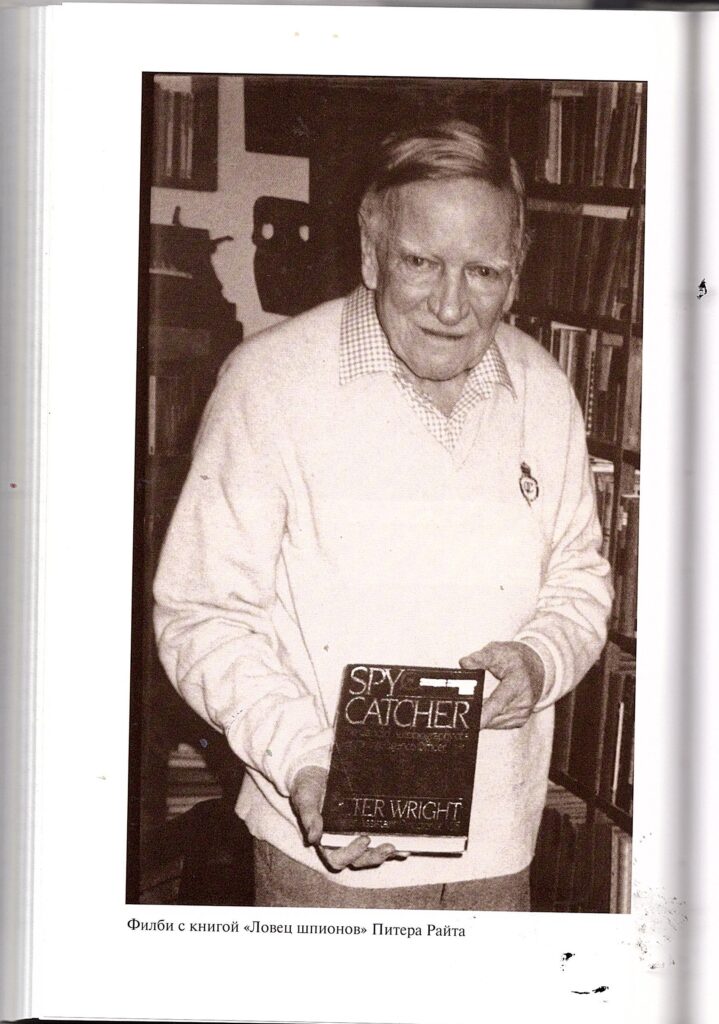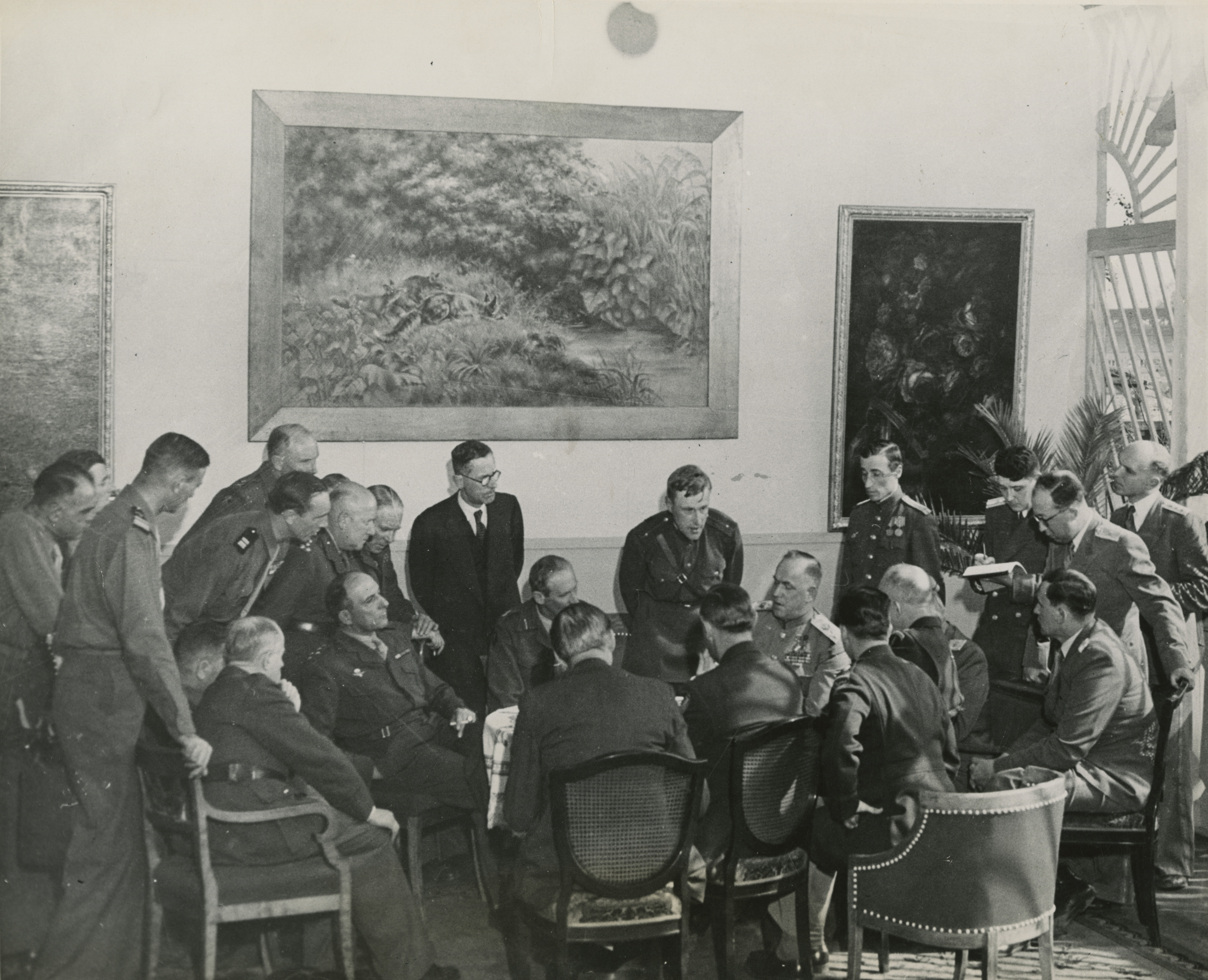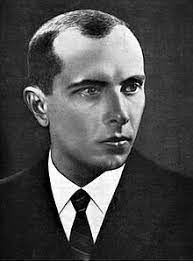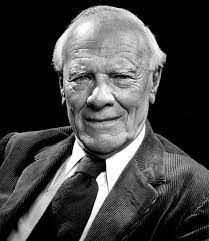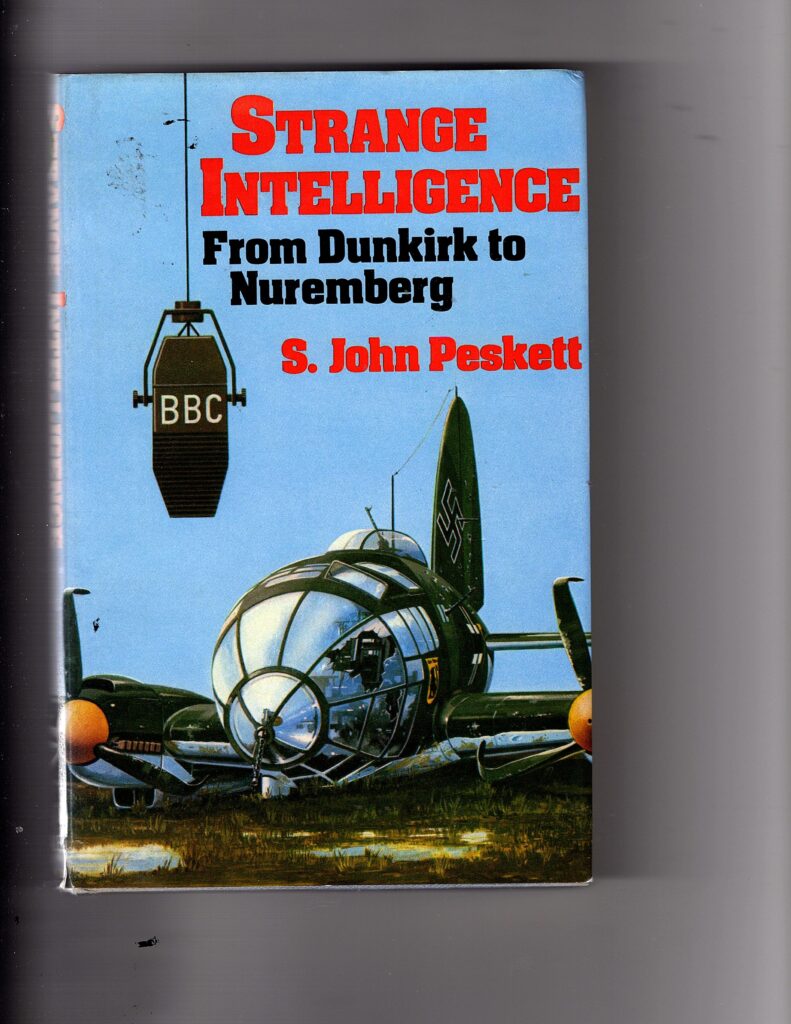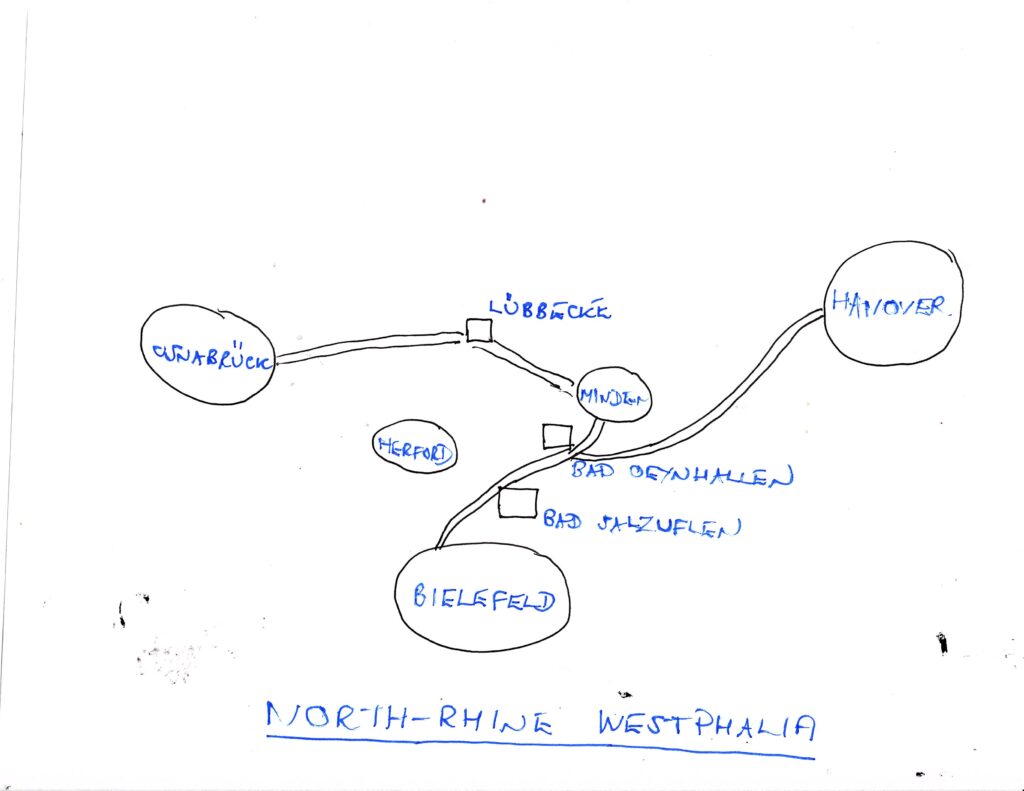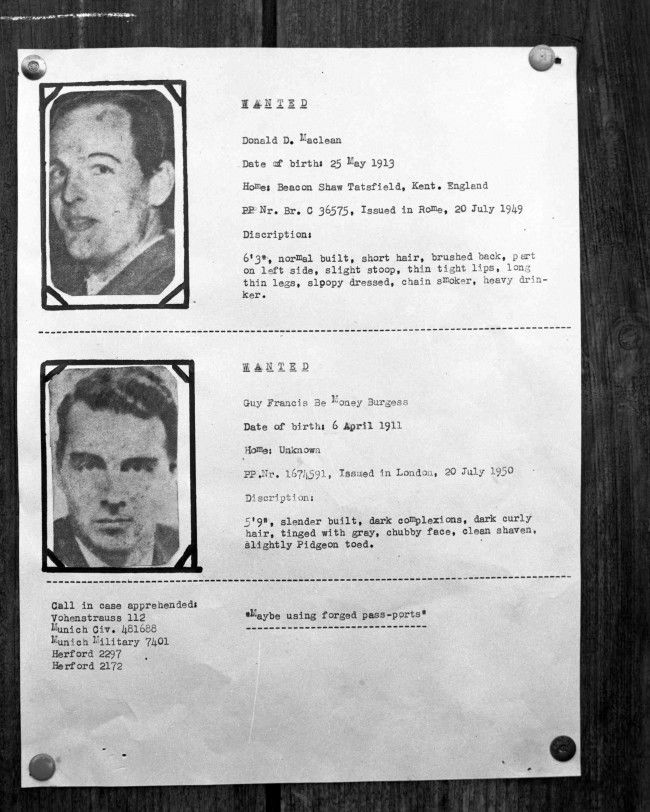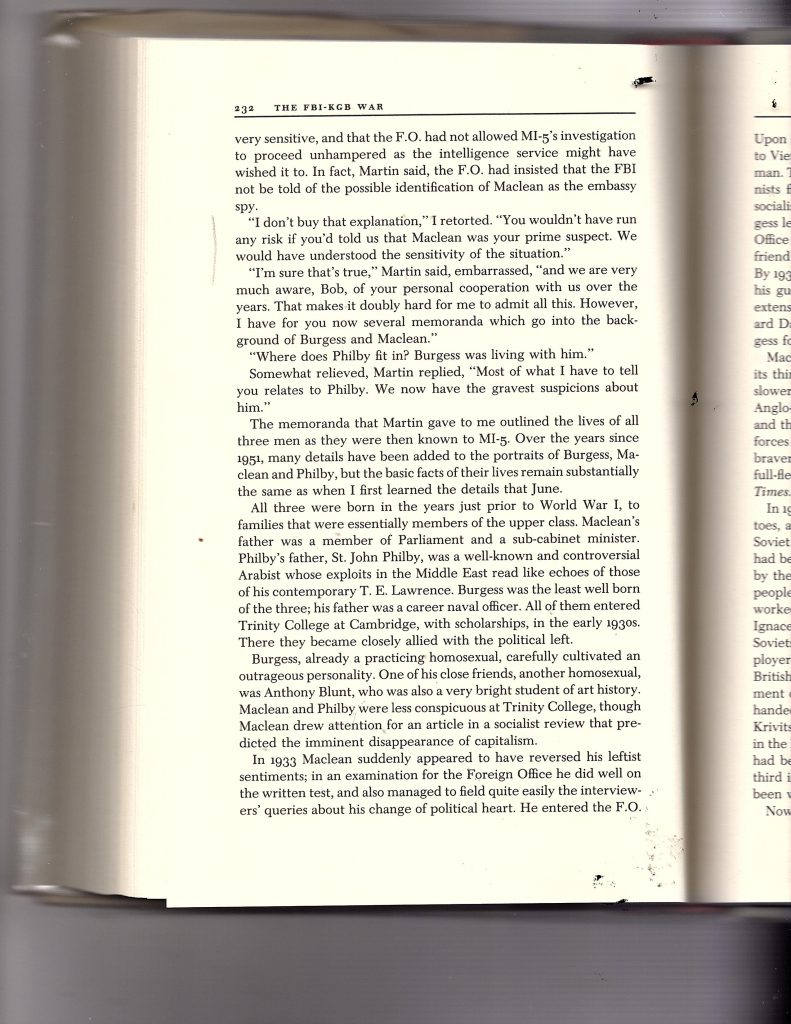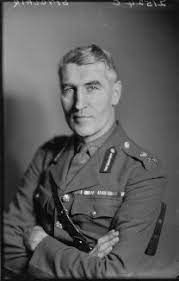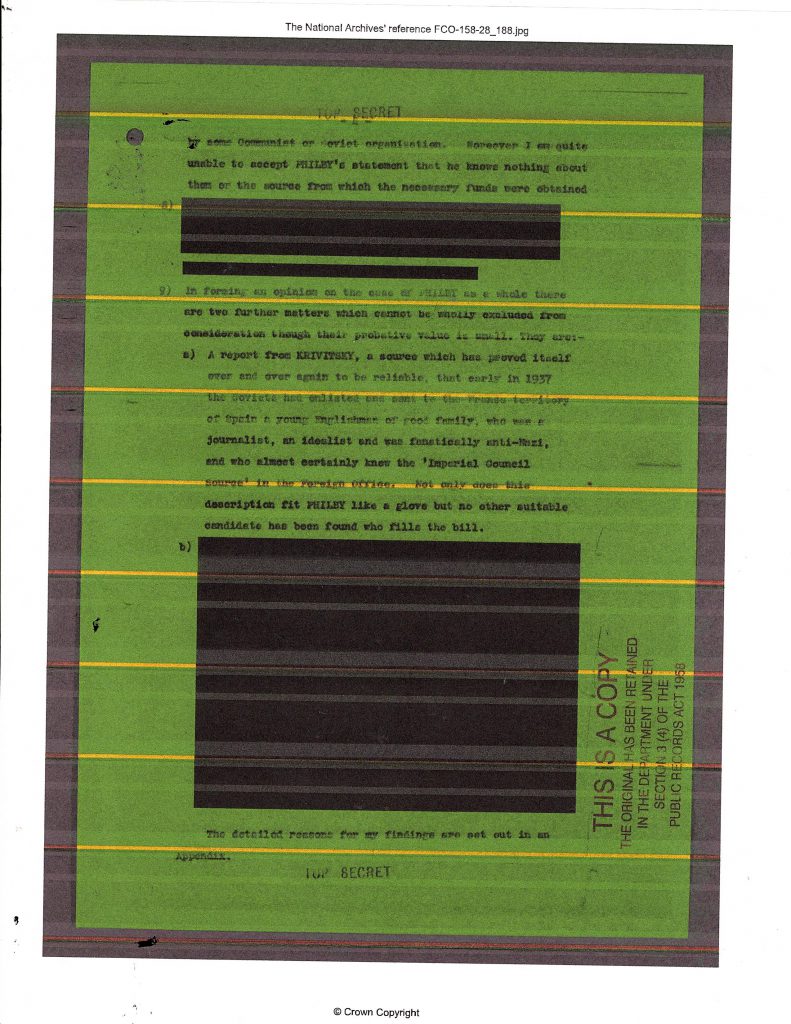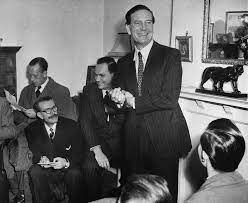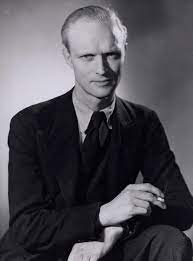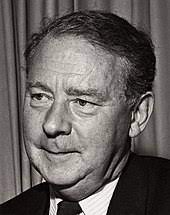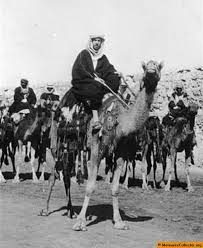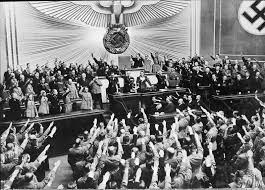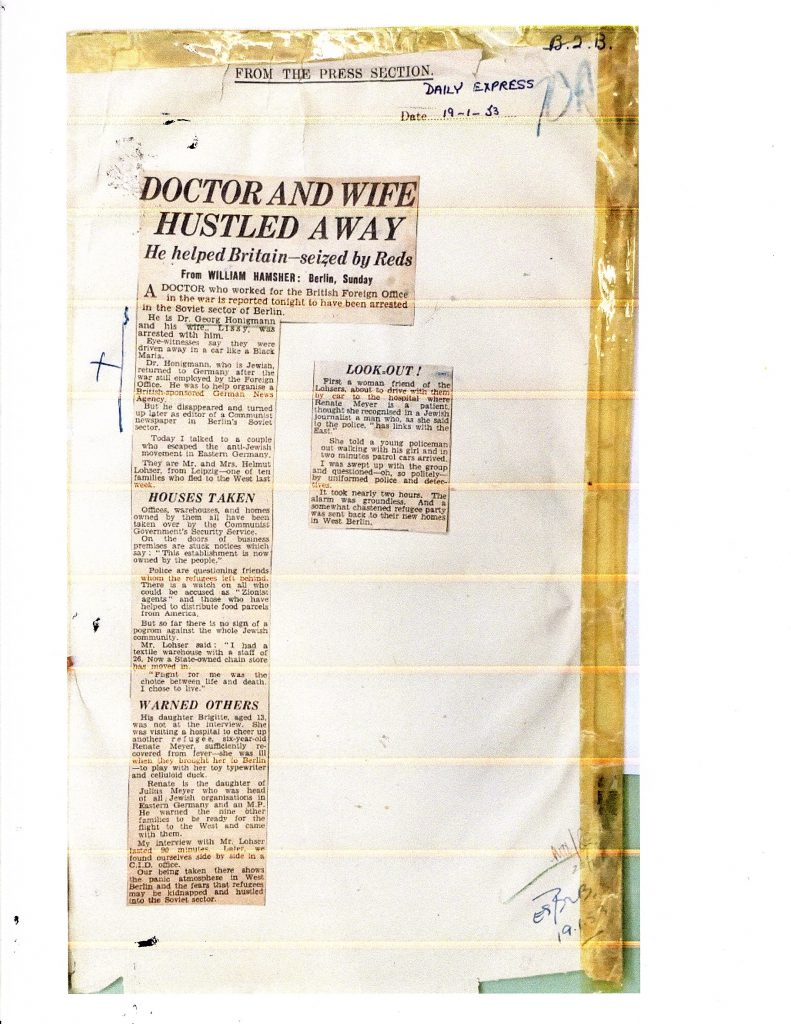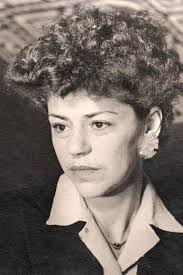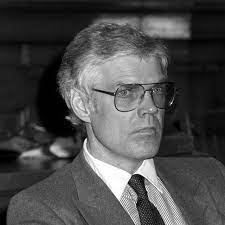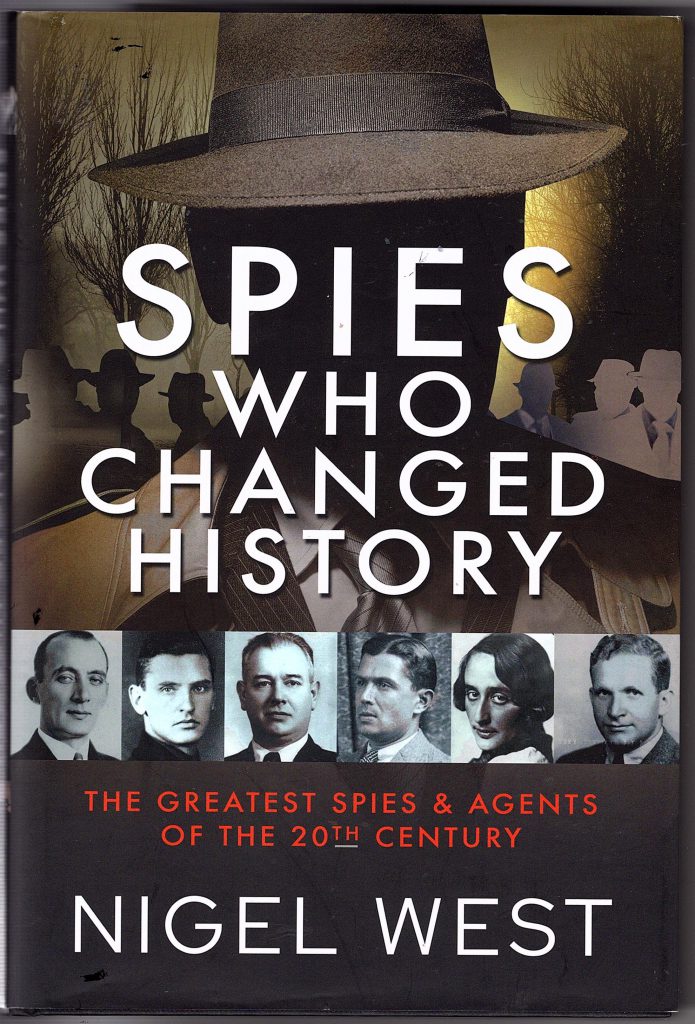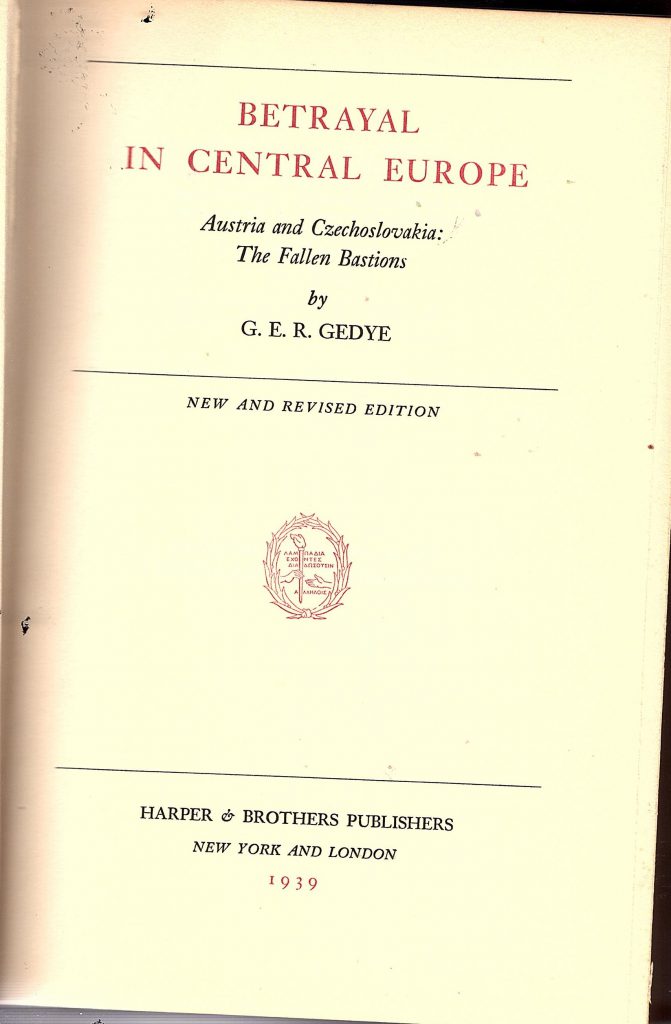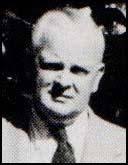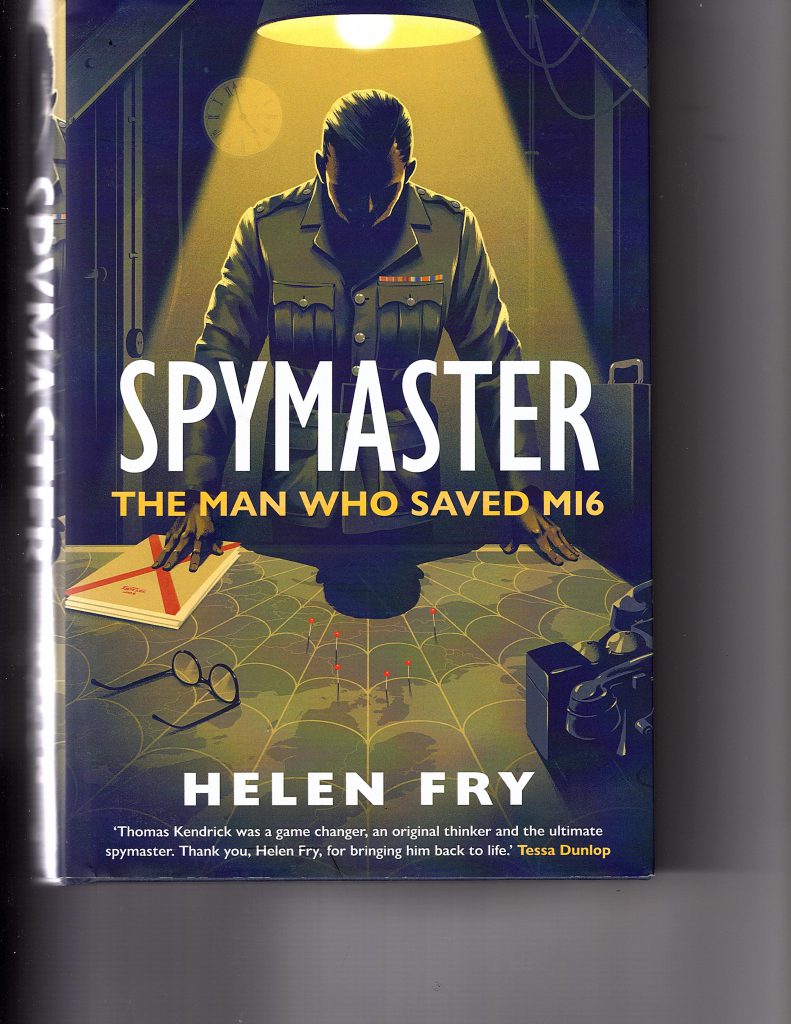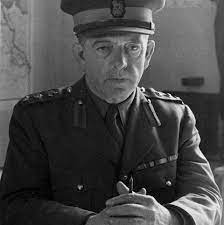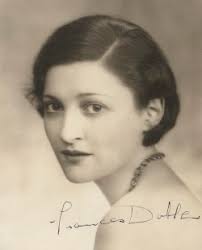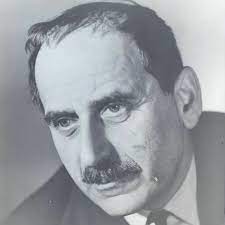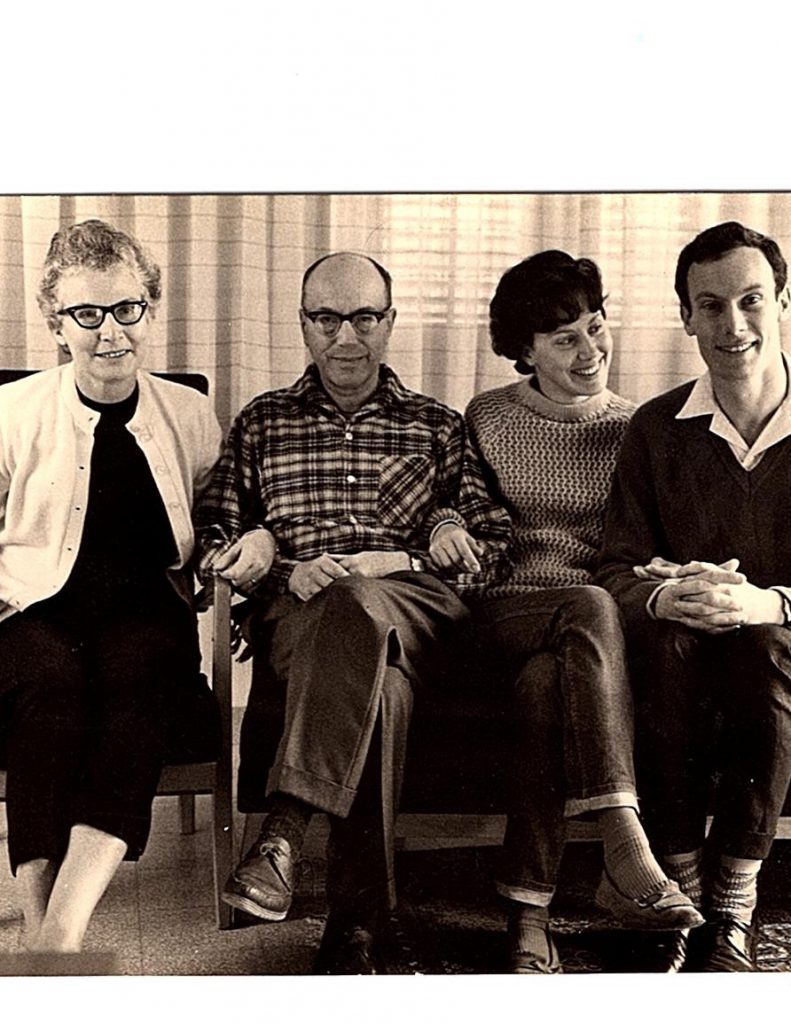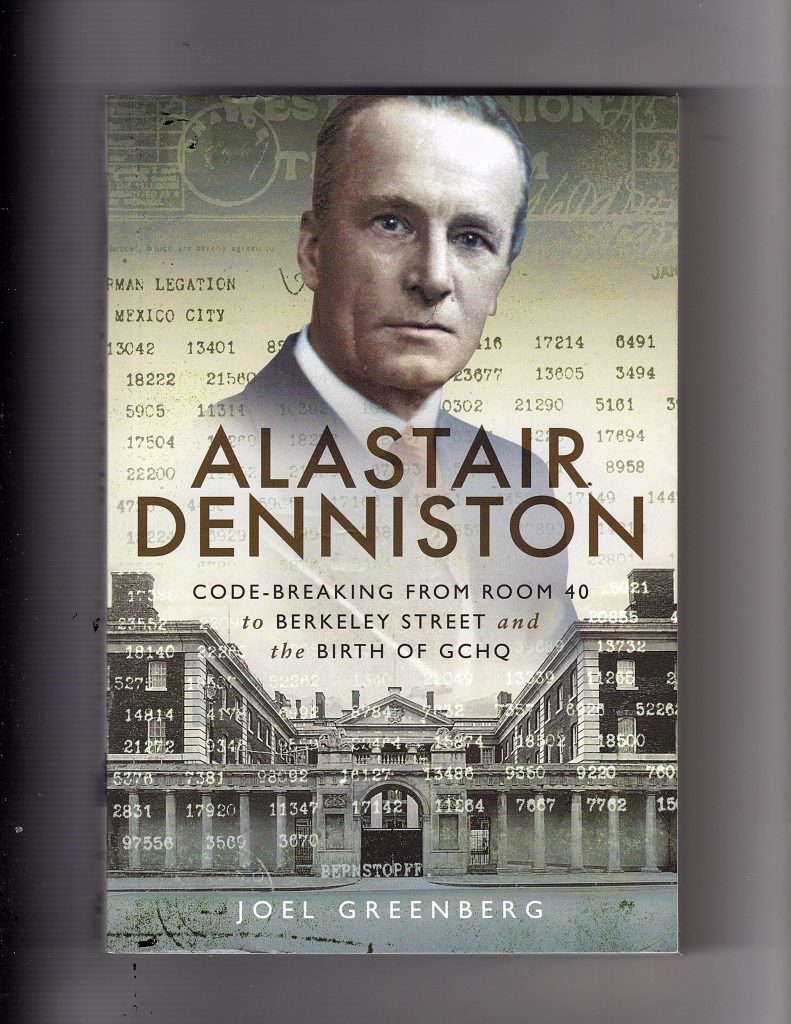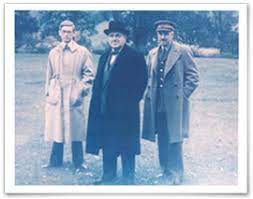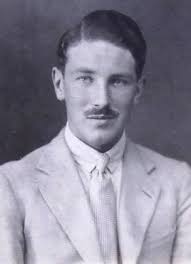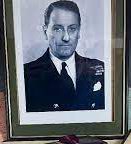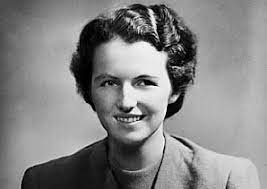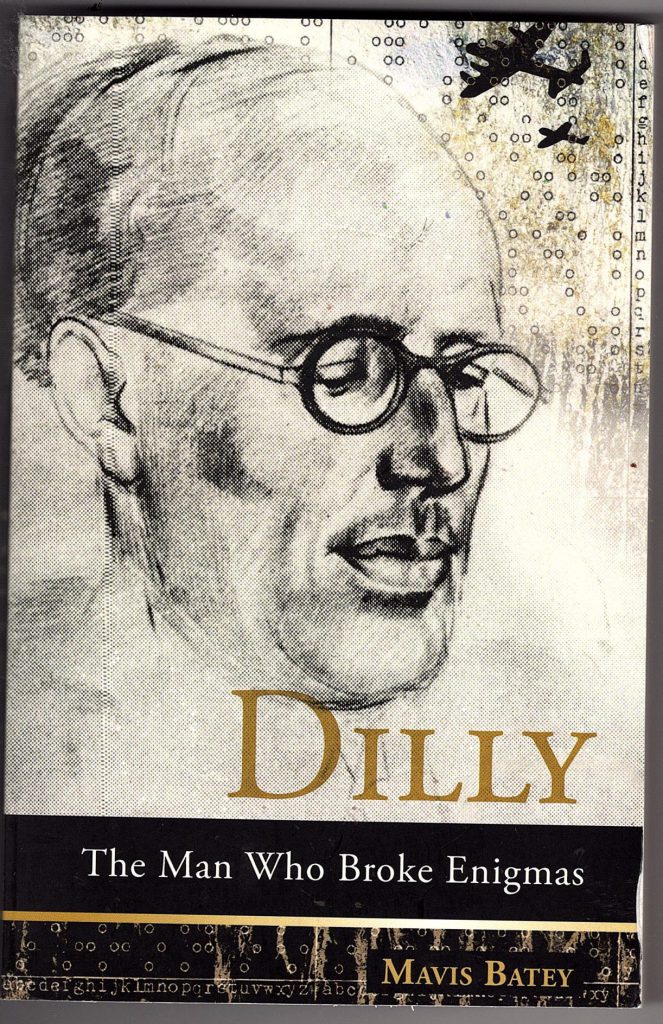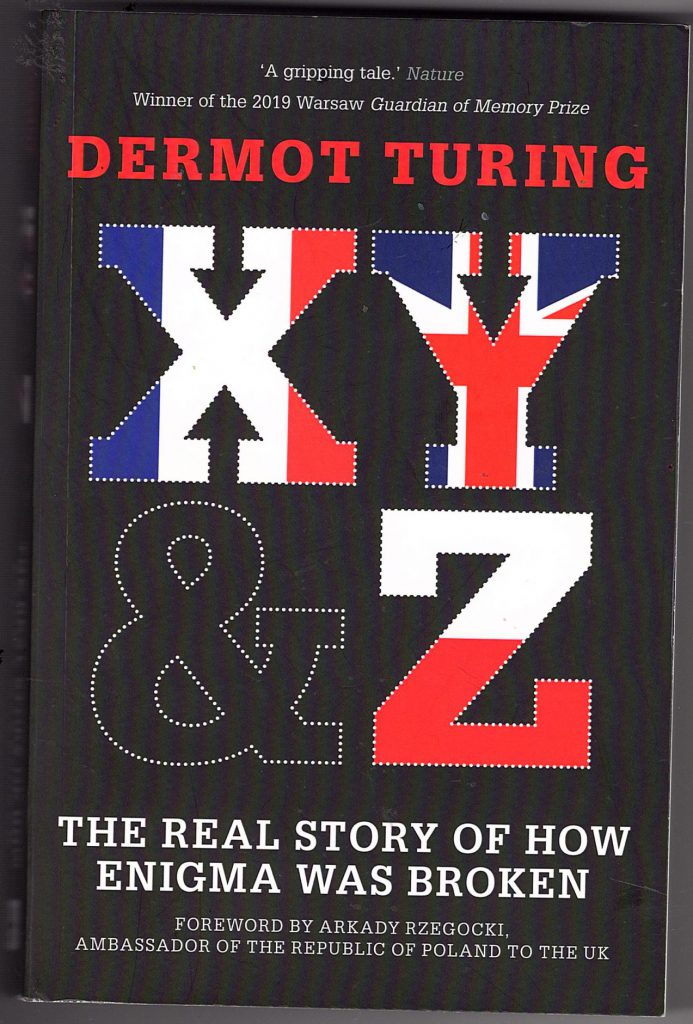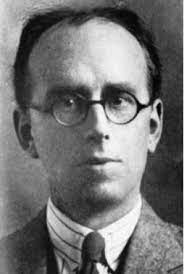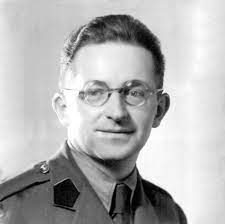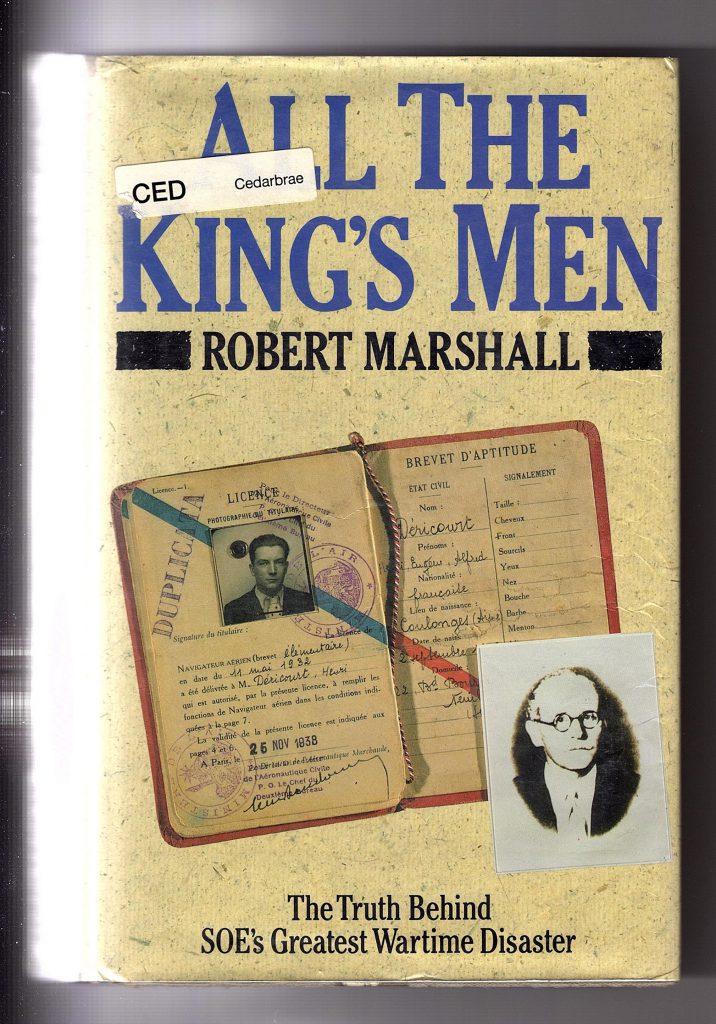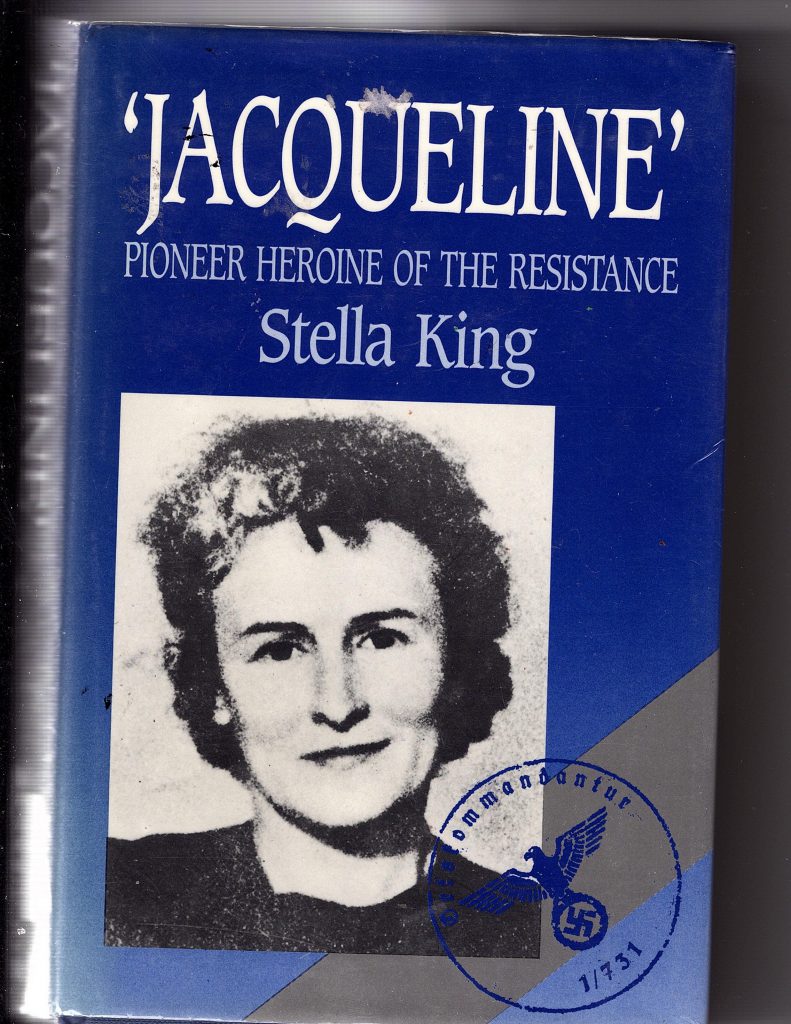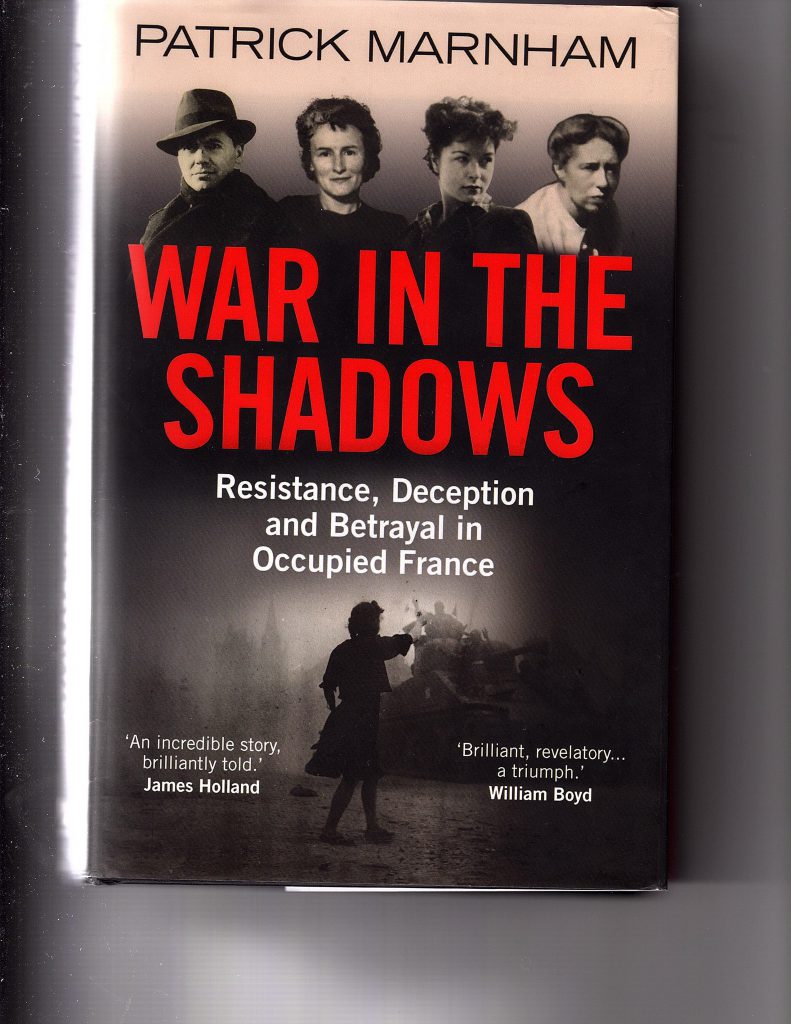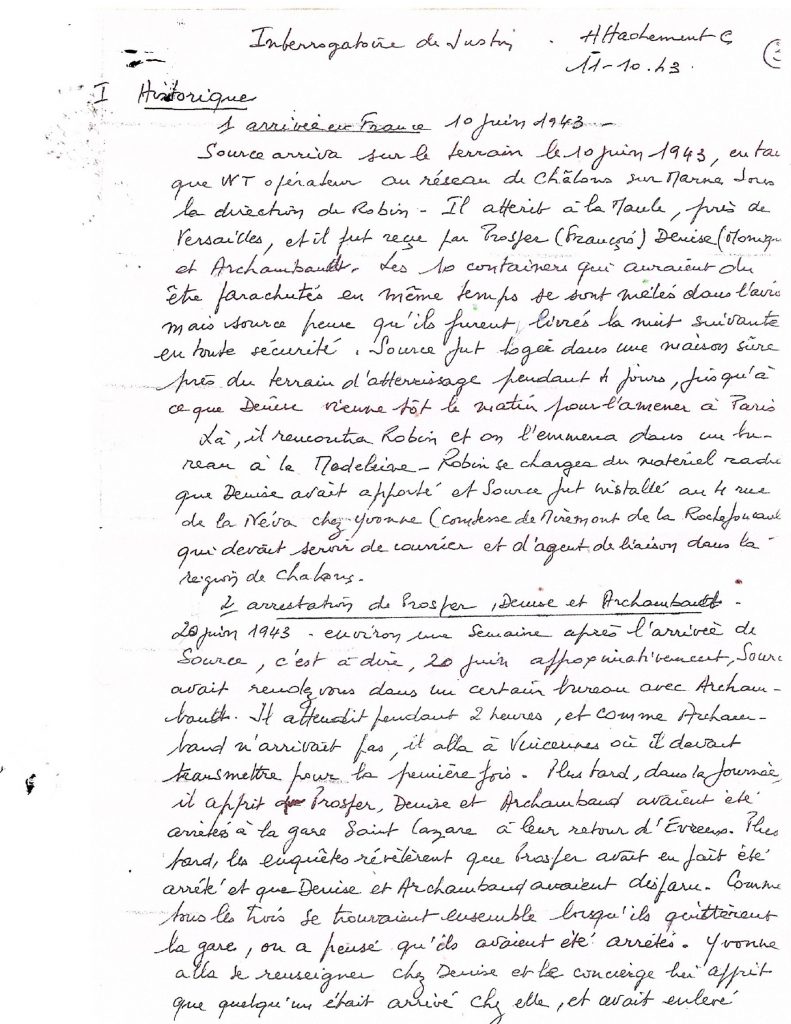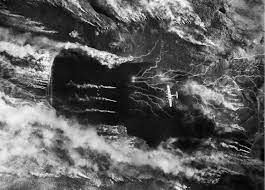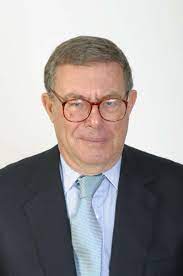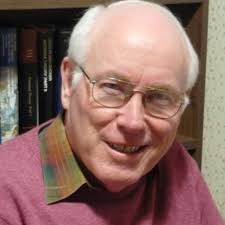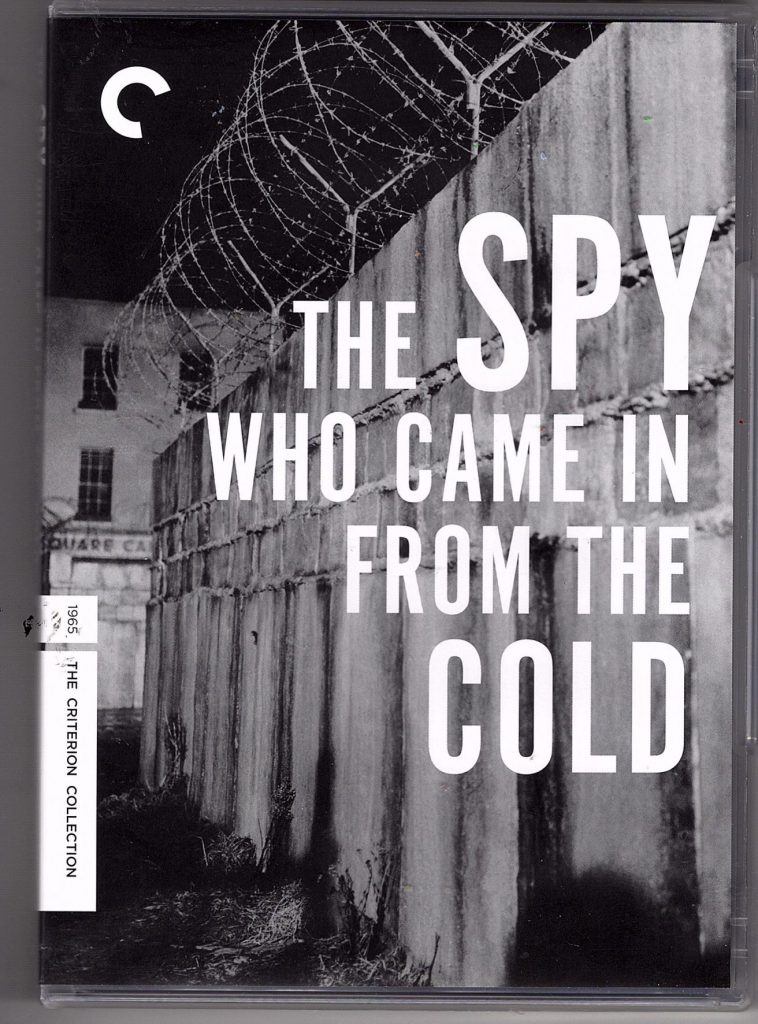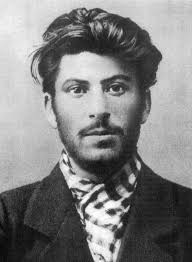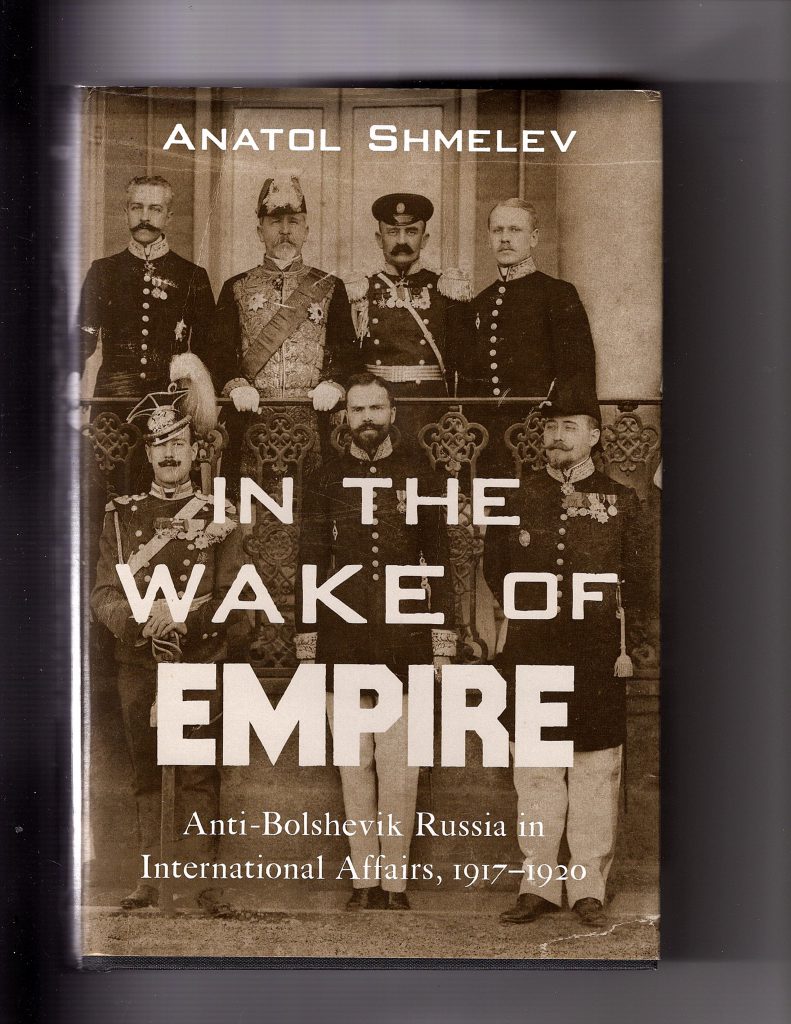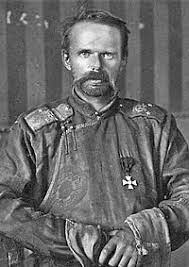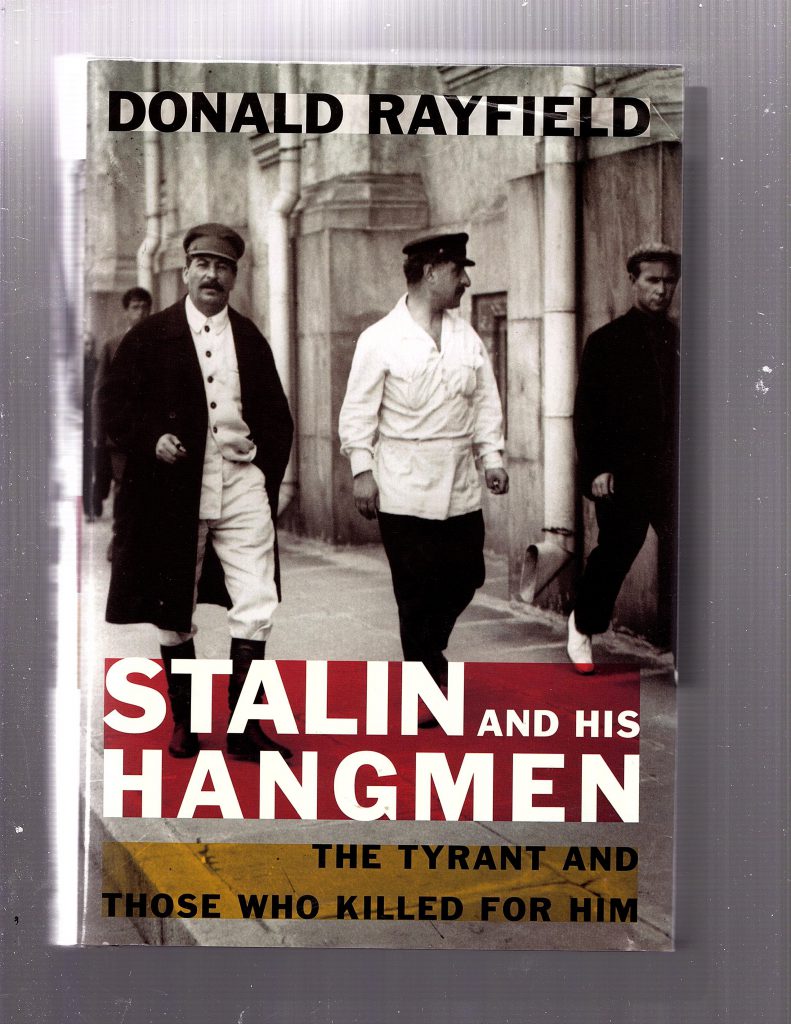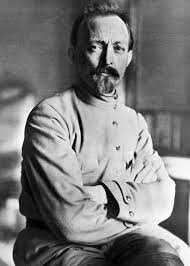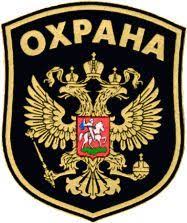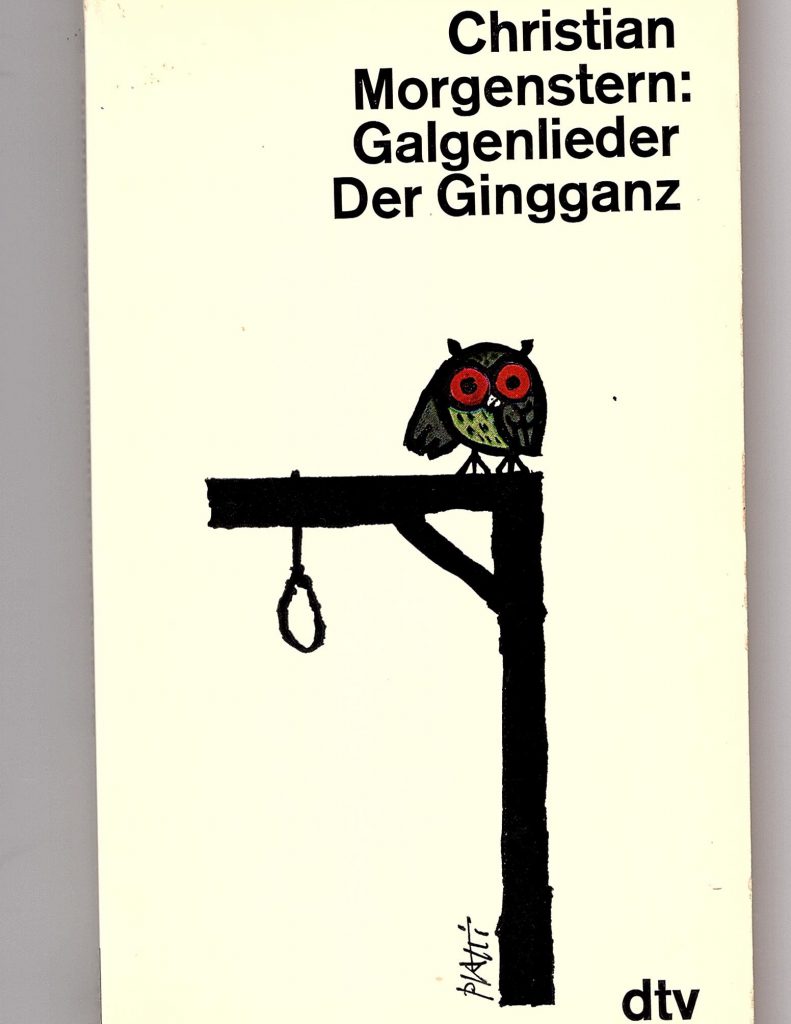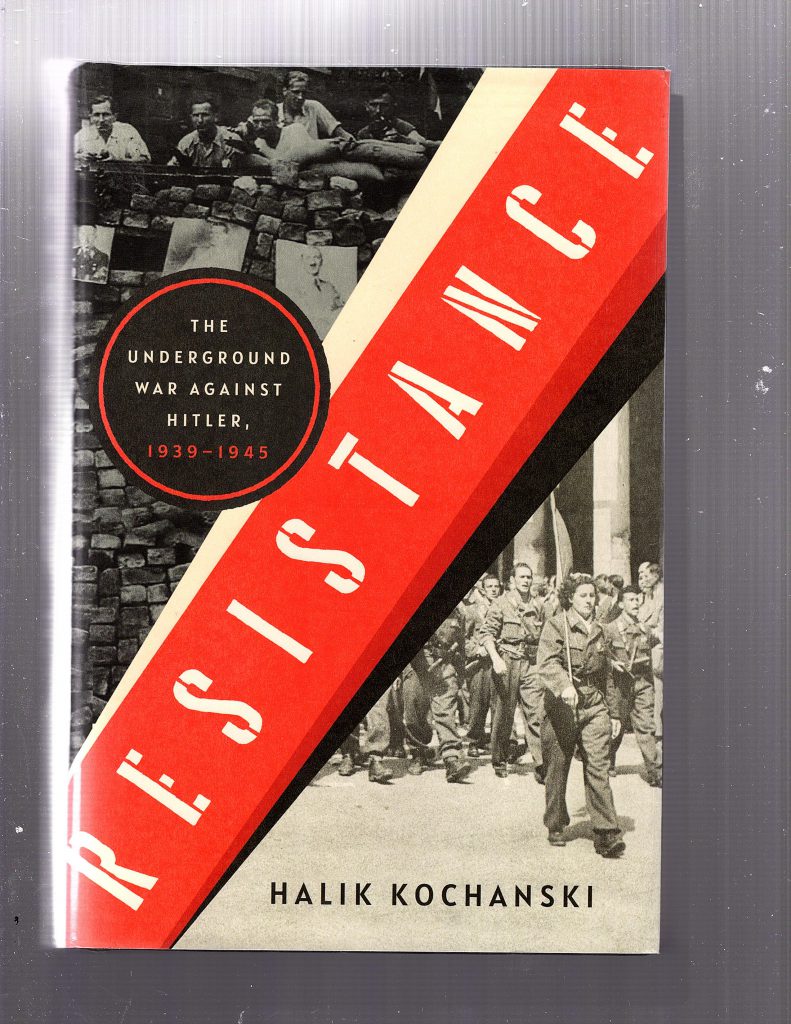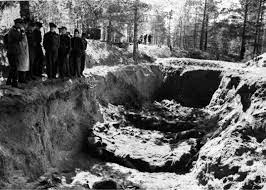
Contents:
Introduction
Flora Solomon’s Life
The Mysterious Stevenson
Aileen Philby’s Admissions
At Lord Rothschild’s (1)
At Lord Rothschild’s (2)
Arthur Martin’s Report
The Aftermath
Anatoly Golitsyn
The Rimington Investigation
Analysis of the Rimington Report
Conclusions
**************************************************************************
Introduction
In the old days, before I immersed myself in mid-twentieth century European history, I was wont to confuse pairs of semi-famous figures from the period. Nancy Astor and Nancy Cunard: both Americans who became European socialites. Ernst Toller and Stefan Zweig: Jewish authors, writing in German, who both committed suicide in the Americas. Ignace Reiss and Ignaty Reif: both Soviet illegals in the 1930s – did Stalin have them both killed? Simone Weil and Simone Veil: both French intellectuals of uncertain influence. Hans-Peter Smolka and Engelbert Broda: both Communist spies, but who did what? And Moura Budberg and Flora Solomon: both Jewish grandes dames from Russia, but which was the mistress of Alexander Kerensky, and which that of H. G. Wells? And were they both spies?
I believe I have straightened matters out now, and this month’s bulletin is about the highly controversial Flora Solomon. She reputedly plays a significant role in the Philby saga because she revealed to Victor Rothschild in 1962 that she had known that Philby was a Communist agent since he had approached her to join him in ‘working for peace’. According to some accounts, that disclosure apparently helped MI5 seal the deal against the traitor. Indeed, that tireless investigator into Philby’s naughty deeds, Ben Macintyre, characterized Solomon as his ‘hero’ in a typically error-strewn piece in the Guardian of April 4, 2014. (see https://www.theguardian.com/books/2014/apr/04/my-hero-flora-solomon-ben-macintyre) One might almost forgive the overwrought cliché ‘changed the course of British history’, but the byline ‘Flora Solomon provided MI5 with the evidence they needed to arrest Wilby’ is simply comical. ‘Wilby’ was not arrested, but fled from Beirut in 1963 after giving a half-baked ‘confession’ to Nicholas Elliott. And, in any case, why did Solomon maintain her silence for so long? She would have been much more of a ‘hero’ if she had gone to the authorities with her knowledge in 1951, when Burgess and Maclean absconded.
This story is, however, much more complex, imbued with the prevarications and dissimulations of Solomon herself, as well as a hefty dose of self-deception and obtuseness on the part of MI5 officers. The sources are primarily the three files on Solomon held at the National Archives (KV 2/4633, 4634 & 4635, not released until October 2022). These files have been quite heavily redacted – a rather surprising phenomenon, given the subject, and the passage of time. My analysis below will offer a reason why.
The archival material is complemented by various memoirs and biographies, of which the main volumes are Solomon’s own contribution From Baku to Baker Street (1984), Peter Wright’s Spycatcher (1987), Nicholas Elliott’s Never Judge A Man By His Umbrella (1991), Tom Bower’s The Perfect English Spy (1992), Genrikh Borovik’s The Philby Files (1994), Phillip Knightley’s The Master Spy (1998), Stella Rimington’s Open Secret (2001), and Ben Macintyre’s A Spy Among Friends (2014). (In A Spy Among Friends, Macintyre includes as an Afterword a text given to him by John le Carré, which the latter published in a slightly expanded version in The Pigeon Tunnel (2016). It is essentially a record of what Nicholas Elliott told the author about Philby and other personalities in MI6.) I mention also the disclosures from Soviet archives revealed in The Crown Jewels, by Nigel West and Oleg Tsarev (1999), while Christopher Andrew’s Defend the Realm (2009) provides some vital insights.
Flora Solomon’s Life
Born Flora Benenson in Pinsk (now in Belarus) in 1895, the subject of this profile moved with her parents to Britain in 1914, leaving the family’s considerable wealth, in oil and gold, behind. Her father’s face had been disfigured by a jealous mistress, and they sought medical help abroad. After a circuitous route via Stockholm and Hamburg, they landed in Newcastle. In 1917, Flora was introduced to Colonel Harold Solomon, and married him the following year. The couple then spent several years in Palestine, where Solomon was an aide to the British High Commissioner, Herbert Samuel. In 1921, Flora returned to the United Kingdom to give birth to a son, Peter Benenson (who founded Amnesty). In 1923, Harold was paralyzed in a hunting accident, and the couple returned to London, effectively leading separate lives thereafter. In 1927, Flora met the former Russian leader Alexander Kerensky in New York, and began an affair with him, which continued when Kerensky established himself in Paris. Her husband died in 1930. Flora was active in Zionist causes, but ideological splits between her and Kerensky, specially concerning Kerensky’s disgust for Stalin, caused them to break up. In the 1930s, after meeting Simon Marks at a dinner, Flora had become a vigorous defender of workers’ rights at Marks and Spencer, and served as the only woman in the company’s executive ranks. She remained an energetic Zionist all her life, and died in 1984.
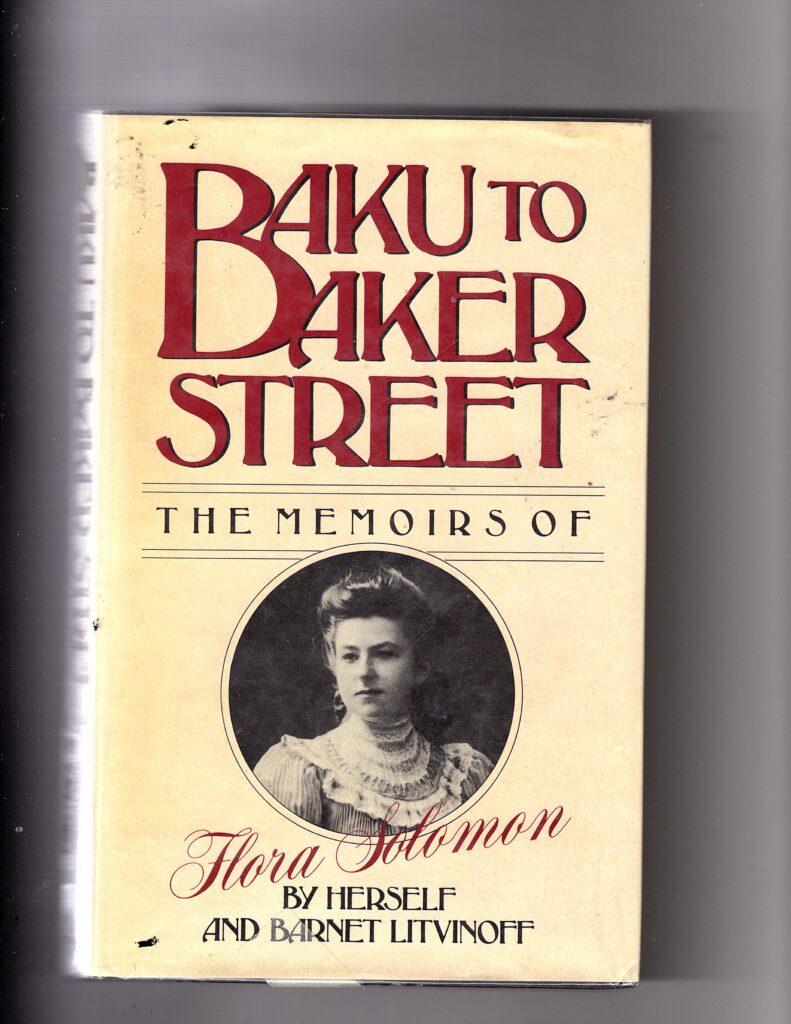
Flora Solomon’s memoir, From Baku to Baker Street, written with the help of Barnet Litvinoff, a Zionist historian of some repute, appeared that same year. (Litvinoff had an interesting history. He was born in London of Russian immigrant parents in 1918, was in the Army for six years, seeing action at Dunkirk, and was captured during Rommel’s advance in the Western desert, surviving three years as a prisoner-of-war in Italy and Germany.) I here focus on the various statements Flora made about her relationship with Kim Philby, and on Communism in general, as they represent useful signposts to the archives that were released many years after her death.
Her first exposure to Kim was in 1921, when she met St John Philby and ‘his attractive wife Dora’ in Jerusalem, the elder Philby working at that time for Samuel. She recalled the ‘stammering young son’, who would have been aged about nine at the time. (She later recalled that he was eleven.) Flora’s application of chronology is rather wayward, but, from the surrounding narrative, it would seem that she met Philby again at some time between Oswald Mosley’s rally at Olympia in June 1934 and the promulgation of the Nuremberg Laws of September 1935. Flora’s ‘muddle-headed’ friend Dulcie Sassoon invited her to her house in the country, and Philby was also present. He did not recall the previous encounter, but ‘he introduced me to his Jewish wife, the Viennese Litzi Friedmann, and I gave them my address (I was living in Addison Road). Gradually a friendship developed.’
Flora went on to write:
It caused me no disquiet when my housekeeper, Bella Meyer, a refugee from the Continent, informed me that she had known Litzi’s family in Vienna, and that Kim’s wife had been a Communist. Only years later, after Kim’s defection to Russia, did I learn with everyone else that he had a cover job with a pro-Nazi organization, the Anglo-German Fellowship. The Kim Philby I got to now was not a talkative man; he had a gentle charm, never drinking to excess at my house, and mingled easily with my friends.
Among such friends were noted left-wingers like John Strachey and Stafford Cripps, and ‘a liberal sprinkling of my Zionist contacts.’ It is perhaps puzzling how Philby managed to keep his new affiliation secret in such adversarial company (he joined the Fellowship in January 1936).
And Philby did not succumb to Flora’s Zionist propaganda:
He evinced not the slightest interest in the Palestine conflict. Neither did Guy Burgess, who occasionally arrived with Kim. My recollection of the latter is borne out by what others have written of him: he was a grubby, uncouth specimen but a fascinating conversationalist.
One reflects on how Flora might have recalled this friendship after the disappearance of Burgess and Maclean in 1951.
The next encounter is marked as occurring just before Philby left for Spain in 1937. This must be his second visit, after he had been commissioned by the Times to work as an accredited journalist, sometime in June (he left on June 10). Flora describes it as follows:
Kim Philby came to see me before leaving for Spain in 1937. I attached no significance to the news that he was to report the war from the Franco side. I remember the day well. I think he wanted to tell me more. ‘I’m doing important work for peace’, he said. ‘You should be doing it too, Flora.’
Her response was distinctly incurious:
‘I have my own cause,’ I observed. ‘Who’s going to help the persecuted Jews, if not their own people?’
There is no suggestion that she did not understand clearly what ‘working for peace’ meant, and she was not at all surprised that Philby, married to a committed Communist, would be engaging in subterfuge by reporting the war from the Franco side.
Sometime after this (according to Flora’s account), she introduced Kim to a woman called Aileen Furse, who was the cousin of a colleague of Flora’s at Marks and Spencer, Neil Furse, and whom Flora had hired as an assistant. Maddeningly, no date is given, but the suggestion is that it must likewise have occurred after Philby’s spell as a freelance journalist in Spain (he returned on May 24, 1937), and before his posting as an official Times correspondent. Yet Flora’s timetable does not make sense, since she describes it as follows:
Aileen Furse soon established herself as one of my principal assistants, all of whom dropped in at my home for the occasional drink. She was there one day when Kim Philby arrived, now separated but not divorced from his Litzi. Kim plonked himself in an easy chair and began talking about Spain. He found an avid listener in Aileen, and the two left together. The next I knew they were sharing a flat.
This account is markedly at variance with descriptions she later gave her MI5 interrogators (in one of which Kim met Aileen the day war broke out, in another the encounter occurred after Dunkirk): it is difficult to imagine how Flora could have misattributed it so badly.
Yet she compounds her problem by next placing Kim and Aileen at her house ‘just before Munich’, i.e. in about August 1938, when another momentous exchange took place:
As they left a party in my home – this must have been some time in 1938, just before Munich – Kim took me to one side, looking morose. ‘I want to tell you’, he said, ‘I’m in great danger’. It dawned on me then that he was still associated with the Communist Party, the cause that he had espoused at Cambridge. The statement was extraordinary, perhaps, but the intimation of his affiliation provoked no suspicion. What was dangerous in Britain about being a Communist? In some circles of the intelligentsia it was the done thing.
If part of this story is true (i.e. that Philby did confide to Flora his imminent danger at that time, but not when accompanied by Aileen), it would point to a hitherto unreported return to the United Kingdom by Philby during his second stint in Spain. From all the accounts I have read, Philby did not return to British soil until August 1939.
So was Flora Solomon making this up completely? I think it unlikely. What I believe is far more probable is that she received a message about Philby’s danger, either from Litzi or from Guy Burgess, but felt that she should pretend that she was not on such familiar terms with either. She showed a good amount of disingenuousness, however, in her comments. What had Cambridge University to do with the case? She knew that Philby remained a committed Communist because of the ‘working for peace’ slogan. And she grossly misrepresented the danger that Kim must have sensed. It was not the British authorities by whom he felt threatened: it was Stalin and the NKVD. 1938 was at the height of the purges. In 1937, Brian Goold-Verschoyle, a courier in Spain, had been abducted to Moscow for defying orders, and was probably shot soon after. Philby had just failed in the operation to assassinate Franco. In July, Alexander Orlov, Philby’s handler in Spa, had defected. Philby’s past mentor, Theodore Maly, had been recalled to Moscow, and shot as a foreign spy in September. Ozolin-Haskin, who ran Philby from Paris, was later shot.
Philby probably did not learn all these facts at the time, but the menace was clear. So why did he contact Solomon? It must have either been because of an emotional connection (some suspected that they had an affair, but Solomon denied it) or because he believed that she was influential enough that she might be able to help him by putting in a good word. Yet I do not believe that anyone has picked up the chronological impossibility of his issuing a cry for help in person.
The next major event that Solomon records is the marriage between Aileen and Kim, and her account is predictably strewn with errors:
Litzi Friedman, partner in Philby’s first uneasy exercise in matrimony, had lived the war out in London with another man. In 1945 he took a post in East Berlin and before joining him there she and Kim were divorced. So it was at last possible to do the right thing by Aileen. Would I, asked Kim, be a witness?
She covers the Burgess and Maclean abscondment, the suspicions over Philby, and the death of Aileen in puzzling circumstances after she had been abandoned by Kim, before moving to ‘one of the more distasteful episodes of her life’, namely her revelations over Kim to Lord Rothschild. Solomon had become disgusted with the anti-Zionist tones of Philby’s articles as an Observer correspondent, and when she encountered Rothschild at the Weizmann Institute of Science in Rehovot in 1962, her frustration erupted:
In my exasperation with the Philby articles I suddenly exclaimed to Victor, ‘How is it the Observer uses a man like Kim? Don’t they know he’s a Communist? You must do something!’ Victor appeared startled, replying: ‘I will think about it’.
Now, an observant reader of this anecdote might surmise that, for a person in Rothschild’s shoes, learning that Philby was a Communist would have been as shocking as hearing that the Pope was Catholic. After all, a careful study of his file in 1951 (see https://coldspur.com/kim-philby-in-1951-alarms-and-diversions/ ) would have indicated with little doubt that Philby had been a Communist of long standing. Why would the hearsay testimony of a perhaps bitter woman change the equation in any way, since Philby could simply continue to deny everything?
Nevertheless, Rothschild did follow up, and a confidential meeting was arranged at Rothschild’s flat in London ‘with a security official’ [Arthur Martin, unidentified]. According to Solomon, she disclosed several items: Philby’s invitation to work for peace; the belief that he expressed after the fall of France that the Fascists could be beaten only with Russia’s help (hardly a heretical opinion for the time); his intimation of being in great danger; and a voluntary statement from her that she believed that Philby’s close friend Tomás Harris was probably involved in the same game.
Apparently this was enough to complete Philby’s dossier. The rest we know: Philby disappeared from the scene, turned up in Moscow, received citizenship, wrote a book, and entered the chronicles of treachery as the ‘Third Man’.
What Solomon does not mention is that Harris was killed in a suspicious motor accident in Mallorca in January 1964, and that she might therefore have contributed to his demise.
A notable oversight in Solomon’s story is that she writes nothing about Frank Birch and the enigmatic interview he had with Philby for a position at GCHQ early in September 1939, in an episode where the record of the first encounter between Kim and Aileen clearly contradicts her published story. This was a narrative that emerged from her interviews in 1962, and from inquiries that followed them, and she obviously felt uncomfortable about it, maybe believing that the disclosures would remain buried and secret in the MI5 archives. What she does reveal, on the other hand, is that Eric Strauss, the psychiatrist who was ‘her dearest friend’ – and who plays an important role in this saga as it develops – was in fact a homosexual, intelligence that contradicts the assumptions made by MI5 officers that he was her lover. She also informs her readers that her son Peter (who took the name Benenson at the request of Flora’s father) worked on ULTRA decrypts at Bletchley Park.
In many ways, therefore, Solomon’s memoir is a mendacious account. It reflects the internal struggle that some Communist sympathizers or activists (such as Klaus Fuchs) experienced after they had spent some years in Britain – that there was something decent about life there that deflated all the egalitarian but cruel dogma that emanated from Communist ideology, and it was thus incumbent upon them to play down their previous political beliefs. Flora Solomon’s sympathies gradually changed, and she came to feel disgust for Kim Philby’s betrayal of values that she had come to treasure. Yet her lies and contradictions bespeak a more furtive occupation. Perhaps in an attempt to blur it, she wrote, at the end of her memoir, in cadences that were almost Orwellian or, since she was a Russian émigreé, that could perhaps be more aptly described as Berlinesque:
Finally, I feel I must voice my gratitude to the country of my adoption. The British, it is frequently said, are an intolerant race, yet I have seen enough of this country and its people to know that being a foreigner is no obstacle to fulfilment here. My Russian accent has never proved a disadvantage. The British must surely rank as the most exasperating, illogical, hypocritical of peoples. But they have a generosity of mind, too, and a humility, and a capacity for endurance which is necessary for true greatness.
The Mysterious Stevenson
Like many things, the Solomon archives can be divided into three parts. There is the physical division into three separate files. And there is a logical compartmentalization, consisting first of the early, mostly desultory combination of postings concerning Flora’s background, and insubstantial events like her reporting a possible German spy; second, the intense interview in 1962 with Rothschild and Martin, recorded surreptitiously, and its after-effects; and third, the later re-inspection of the files in 1971 by Stella Rimington, then a trainee officer, who would become the first woman director-general of MI5.
Among the routine and unexciting entries in the first file (KV2 /4633) lie two extraordinary memoranda, the first dated December 28, 1953, and the second (concealed in the Minute Sheet that introduces the file) three days later. The first item (serial 21A), heavily redacted, has been written by G. R. Mitchell, the head of D Division, and I feel it is so important that I reproduce most of it here:
On 16 and 21 December Xxxxxx Xxxxxx [assumed two words] visited this office to discuss the case of Aileen PHILBY with D.1 and me. He also rang up on 18 December. No very coherent thread was discernible in the story which Xxxxxx told us on these three occasions. The gist of a confused narrative was as follows: –
[about eight lines redacted]
Xxxxxx Xxxxxx had a good deal to say about Flora SOLOMON, the subject of PF.604,692. Flora Solomon is, he said, an arrogant and domineering Jewess and the sort of woman who can exert a strong influence not only over Aileen PHILBY but also over “latent homosexuals like Kim PHILBY” (STEVENSON’s words). (I asked Xxxxxx what the Expression “latent homosexual” might mean, but received no intelligible reply.) Flora Solomon was many years ago the mistress of “KORONSKY”. We asked Xxxxxx who was KORONSKY; did he mean Alexander KERENSKY? Xxxxxxx, who did not seem to have heard of KERENSKY, did not know. Later, during the 1930s, Flora SOLOMON became Kim PHILBY’s mistress. It was she who introduced PHILBY to his present wife. Aileen was at that time living with Frank BIRCH, formerly a senior official in G.C.H.Q., and now, as I understand, both an actor and a don at Trinity Hall. According to Aileen, before the war Flora sent Kim on a mission to Spain to contact a communist who was in trouble with the Falangists. The date of this trip was unknown to Xxxxxx. Aileen had told Xxxxxx long ago that Flora was a communist. After Kim’s resignation xxxx xxx [from SIS?] in 1951, Aileen asked Flora whether she could find employment for Kim in Marks and Spencers, in which firm Flora holds an important post as Welfare Officer. Flora would not do so.
Xxxxxx Xxxxxx xxxxxx Aileen to be still much under the influence of Flora SOLOMON. The latter is at present believed xxxxxxxxxxxx to be the mistress of Dr. Eric STRAUSS, described by STEVENSON as one of the leading London psychiatrists.
[two lines redacted]
Xxxxxx Xxxxxx xxxxxx that STRAUSS knows a great deal more about the security and espionage suspicions connected with PHILBY, BURGESS and MACLEAN than he has any right to. For example, he recently mentioned xxxxxxxxxxxxx that he knew that there was a damning incident in Kim’s past relating to Turkey. Xxxxxx Xxxxxx assumes that STRAUSS gets his information on these matters from Flora SOLOMON, who in turn gets it from Aileen.
One evening during the week ended 12 December 1953 Aileen was on the brink of committing suicide.
Aileen later poured out confidences relating to espionage on the part of Kim, etc., to attempted murder by Kim, to suicide and other colourful stuff. One possible reason xxxxxxxxxxxxxxxxxxxx for these crises on Aileen’s part was a recent remark made to her by Kim. “I suppose I shall be universally blamed as the sort of chap who could desert five children”. She interpreted thus as an indication of an intention on Kim’s part to flee the country.
What should be made of this astonishing testimony? Who is the witness? What can we conclude from the evidence? It is clear that he knows Aileen and Kim well. (He refers to ‘Kim’ in his account, and Aileen told him some time before about Solomon’s Communism.) He seems less well-acquainted with Flora Solomon, but is obviously on close terms with Eric Strauss, who has confided to him a number of ‘secrets’ about Philby with which he is familiar himself, but which, in his judgment, Strauss should never have been told. Strauss appears to have concealed the source of his intelligence from the witness, since the latter assumes, based on the intimate relationship between Strauss and Solomon, and Solomon’s close friendship with Aileen, that Solomon was the messenger of the information. To have gained access to Mitchell, the witness must be someone with authority, probably within MI6, if he was aware of the ‘damning incident in Kim’s past relating to Turkey’ (which must surely be the Volkov affair). It is unlikely that he learned about it from Kim himself if he represented the events in those terms. Moreover, he presents the information in a way that suggests that the facts were obvious to both MI6 and MI5, but were dangerous if delivered to public outsiders. Mitchell is not surprised to receive an approach from the gentleman, even though he expresses surprise at the lack of coherence in his story. Yet the precision of the supposed statements made by Aileen would cast doubt on the fact that they had been passed through an intermediary.
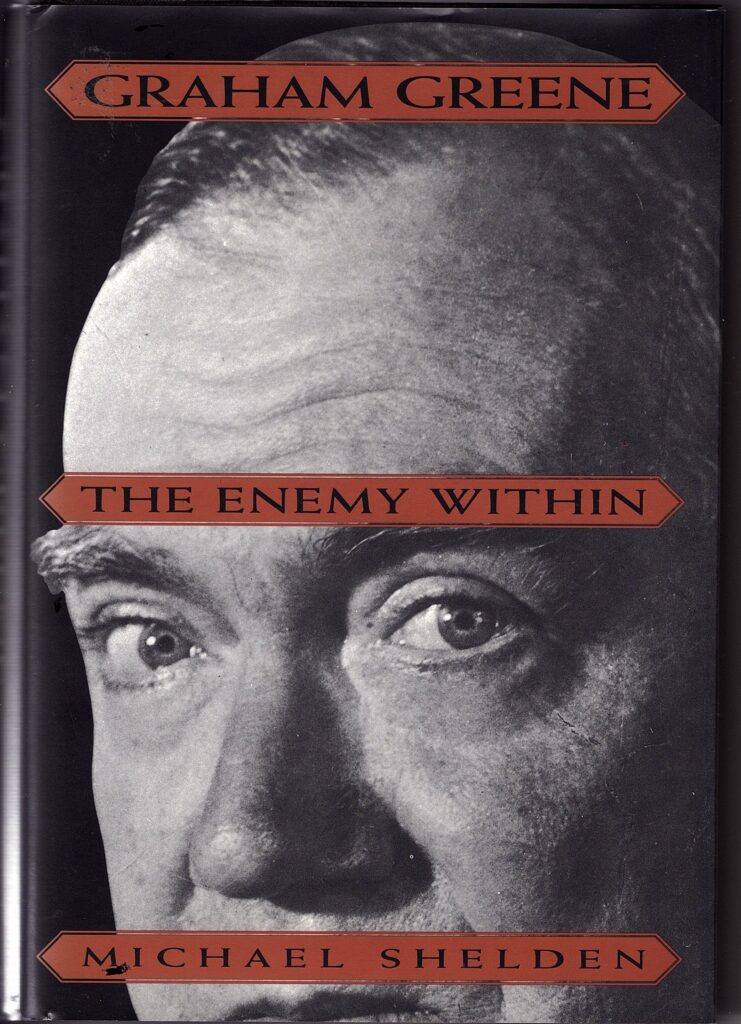
I believe the informant was probably the author Graham Greene. He had been Philby’s deputy in Section V, he had a close friendship with Kim, and he was fascinated both by Philby’s ambition and by his duplicity. Moreover, Greene was a patient of Eric Strauss. In Graham Greene: The Enemy Within, Michael Shelden writes:
The only time that Greene’s behaviour ‘really frightened’ Jocelyn [Rickards] was the day he announced his desire to receive shock treatments from his psychiatrist, Eric Strauss. She could not understand why he would want such drastic therapy.
For most of the 1950s (adds Shelden), Greene was one of Dr. Strauss’s regular patients. Strauss was ‘a prominent psychiatrist at St. Bartholomew’s Hospital and the coauthor of a textbook called Sexual Disorders in the Male’. Moreover, he was a model for a character in Greene’s The Potting Shed – Dr. Kreuzer – who tries to help James Callifer come to terms with his dark memories of childhood.
Greene had resigned from MI6 before the Volkov affair, but may have kept in touch with ex-colleagues, or might even have been confided in by Philby himself. Shelden offers a more complicated explanation for Greene’s resignation than that conventionally given when Philby took over Section IX – that he was shocked at Philby’s naked ambition – writing:
Keeping him at a distance made sense, especially when he began to talk about taking over the new anti-Communist section in the service. Philby’s Communist wife, his determined opposition to Otto John and other conspirators, and his desire to keep anyone else from getting the anti-Communist post – it was all much too suspicious for comfort. And if Philby did prove to be a Soviet mole, it would not be wise to become established in SIS as his protégé, the man he had handpicked to take his old job. The best thing was to keep quiet and get out quickly, far in advance of any promotion for Philby. Greene’s later objection to his friend’s office politics was correct, but it was only half the story.
I suspect that Greene was highly torn over what he had discovered. It would be unusual for an MI6 officer to share confidences with his MI5 counterparts, but his dismay at Philby’s obvious treachery might have been coloured by the mindless defence of his friend conducted by the ‘robber barons’ now in charge at MI6. The impression he gives is that, since he and MI5 know about Philby’s transgressions, he is not betraying his friend through these disclosures. In that mood, therefore, he decided that he should alert Mitchell and his colleagues to the fact that Philby’s secret is known outside the circle of intelligence, while at the same diverting responsibility to a woman whom he represented as something of a she-devil.
But what about ‘Stevenson’? This seems to be a clumsy attempt to conceal the identity of the informant, made, perhaps, in the belief that no one would be able to work out from the alias given from such a name. I swiftly discarded the intelligence officer Bill Stevenson (who wrote the biography of BSC chief William Stephenson) on the grounds of age. But I did notice that Greene’s mother was the cousin of Robert Louis Stevenson, and it might have seemed a cute way of veiling Greene’s identity by granting him this cryptonym – perhaps suggested by Greene himself. Whether Greene would have been ignorant of the existence of Alexander Kerensky is a little problematic, but not enough to collapse the whole theory. The last comment I would make is that Greene appears more sympathetic to Kim, despite the ‘damning’ evidence, than he does to Aileen. Instead of criticizing Kim for his treachery, Aileen for her loose lips (although, unknown to him, delivered in supposed confidence to her psychiatrist), or Strauss for his passing on of gossip, Greene turns his bile primarily on the hapless and non-participating Solomon. Overall, that will come as no surprise to those who have read Greene’s Introduction to My Silent War: Greene may have disparaged Aileen’s apparent betrayal of her husband more than he disapproved of Philby’s treachery towards his country, but he resented Solomon’s presumed gossipiness even more.
Aileen Philby’s Admissions
Follow-up to Stevenson’s contribution appeared to be swift, although the spin and emphasis are slightly different. The second remarkable entry in the Solomon files is a memorandum by Evelyn McBarnet (D1A in MI5), dated December 31, 1953, drawing attention to Flora by virtue of an extraordinary note concerning Aileen Philby. It runs:
It has recently been reported that Mrs. Aileen PHILBY, who has known her for many years, has alleged that Mrs. SOLOMON was a Communist and that she had been concerned in sending H.A.R. PHILBY on a mission to Spain to contact a Communist there.
Note that McBarnet’s memorandum does not refer to the Stevenson insights, nor does it mention Turkey. The use of the passive voice is itself revealing, but provokes many questions and reflections. To whom did Aileen offer this report, and how did it reach the ears of MI5? Why was Mrs. Philby apparently so keen to cast aspersions on both her husband and Mrs. Solomon? This was a time when Philby was in the wilderness, searching for employment, but he was also spending much time away from Aileen, since he had a mistress in London. Without a doubt, however, it shows that Aileen knew much more about Kim’s activities than had previously been credited by MI5, and that she was expressing some sort of grudge against him. But it also places Solomon in a much more dominant and authoritative role, as if she had been responsible for leading Philby astray.
McBarnet’s recommendation is not to follow-up with Aileen, however (which would only publicize the fact of their confidential source), but to apply for letter and telephone checks on Flora Solomon, a move that might appear somewhat unproductive, given that the events had occurred over twenty-five years beforehand. The checks take place for several weeks, until McBarnet concludes on February 9, 1954 that there is no evidence that Solomon is a Soviet spy, or even a Communist, and recommends that the checks be discontinued. In this letter, however, she does record: “Dr. Eric STRAUSS has appeared in the telephone check and it is fairly obvious that he is an intimate and long established friend. They are very discrete about their relationship.”
What clues are there that might point to the source of this extraordinary intelligence? Ben Macintyre offers a typically unverifiable claim, writing (p 179): ‘He [Philby] told friends that Aileen had denounced him to the Foreign Office, and this had prevented him from getting a decent job. He even claimed she had tried to kill him.” No source is provided for this insight, but he was obviously given ‘insider’ information, since he also writes that ‘MI5’s telephone intercepts would eventually fill thirty-three volumes’. Macintyre does, however, cite Nicholas’s Elliott’s memoir, Never Judge a Man By His Umbrella, asserting that Elliott ‘tried to shore her up with financial and moral support’. This is a slight distortion of what Elliott wrote (p 186): “Aileen herself became so hard pressed for cash that she took a job as a cook in London to people living in Eaton Square, where she was close enough to our house in Wilton Street to spend her off duty hours with us.”
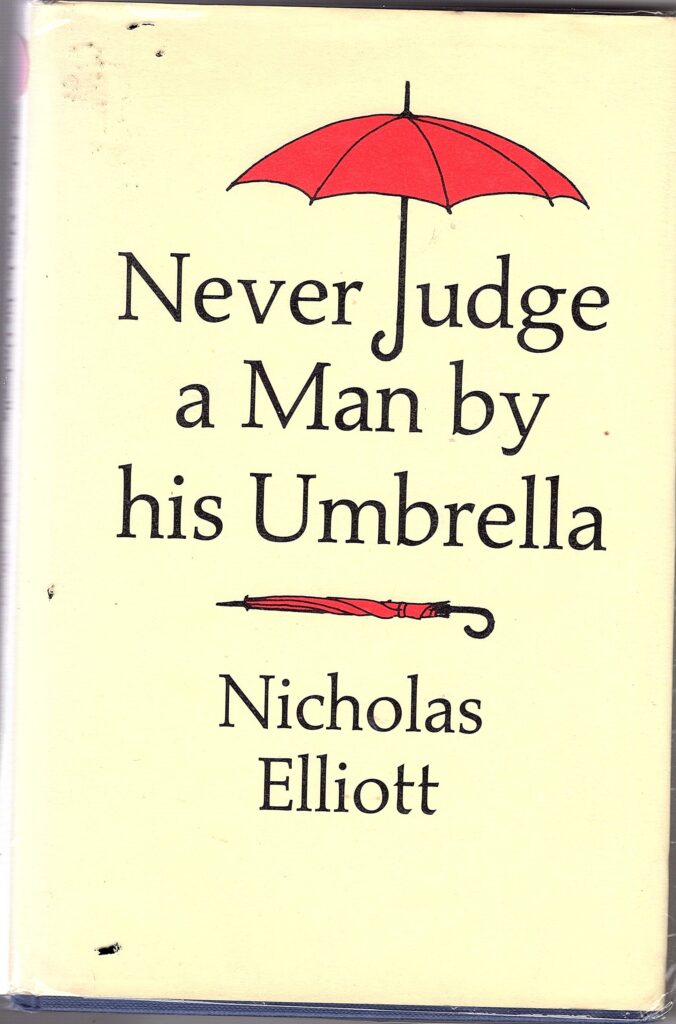
Yet it would be highly unlikely that Elliott, Philby’s closest friend in MI6, would have passed on such confidential information to his adversaries in MI5. (If Philby truly had told friends that Aileen had shopped him, he must have been confident of his colleagues’ support.) The truth is rather more shocking. Macintyre refers to an astonishing passage in Christopher Andrew’s history of MI5, correctly categorizing the behaviour behind it as ‘secret and unethical’, since it was in fact Aileen’s psychiatrist who was passing on information to MI5.
Andrew’s text is shabby and hypocritical. Describing surveillance carried out on Philby at the time (p 433), he writes: “The checks did, however, also reveal much about Philby’s sometimes squalid private life which has escaped the attention of his biographers.” (Since Andrew’s sources are unidentified ‘Security Service Archives’, to which no one else has had access, his pronouncements are especially sophistical.) Andrew continues, without expressing any judgment on the legality of the operation:
Philby’s most abominable behaviour was towards his mentally fragile second wife, Aileen, by whom he had five children. Aileen’s psychiatrist told the Service that among her problems was her belief in her husband’s guilt – which was at least partly responsible for Philby’s attempts to ‘smash Aileen up’: ‘He is convinced that she possesses important security information about her husband and her own Communist past . . . In [Aileen’s]opinion and that of her psychiatrist, Philby had by a kind of mental cruelty to her “done his best to make her commit suicide”.’
It amazes me that MI5 allowed Andrew access to such incriminating material, which shows the Security Service in very poor light. (This is another example of the reprehensible practice whereby an authorized historian is allowed to make categorical assertions that are unverifiable.) But it is also noteworthy, in two dimensions, that this lead was not followed up. First, it shows that MI5 in 1954 was quite unimpressed with any insight that would confirm Philby’s activities on behalf of the Communists in Spain. (Recall that the dossier which MI5 compiled on him in 1951 confirmed that he was the agent in Spain identified by Krivitsky.) The service was overall probably complaisant with MI6’s story that he was an ex-communist who had switched his allegiance. Second, no one appears to have picked up the fact of MI5’s unethical behaviour, or tried to identify the person to whom Aileen Philby had confided her thoughts and fears. Whom would she have chosen as a psychiatrist? It seems obvious to me that her sponsor, Flora Solomon, whom she admired handsomely, might have introduced her to her good friend Eric Strauss. And indeed, if Strauss was providing MI5 with confidential information derived directly from Aileen, that fact would explain many of the mysteries of the Solomon saga.
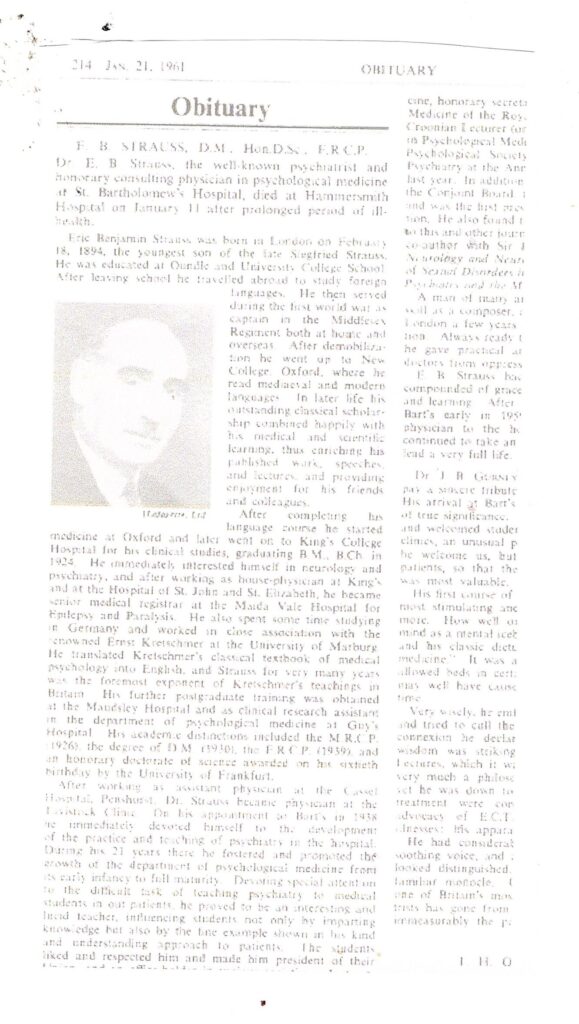
What is extraordinary – almost outrageous – is the suggestion that Strauss had an agreement with MI6 as well. Nicholas Elliott told John le Carré that ‘the office shrink’ (suggesting an in-house resident role rather than an external source) rang Elliott up. Strauss had been treating Aileen (thus confirming my assertion above) and he said to Elliott: “She’s released me from my Hippocratic Oath. I’ve got to talk to you.” No date is given for this episode, but if accurate, it would indicate that, contrary to other reports, Elliott had been convinced of Philby’s guilt some time before, since he even claims that he himself passed on the hint from Solomon to MI5. He also told le Carré that he had ‘always had the feeling that Philby himself would like to get the whole thing off his chest and settle down . . .’. (That ‘always’ is absurdly exaggerated.) I pick up and analyze this highly contentious testimony later in this piece, but his comments would seem to be more a retrospective recrafting of what he believed at that time because of his embarrassment at being hoodwinked so badly by his close friend.
An explanation would be that, after the exchanges with Stevenson, MI5 made a return call on Strauss, and gathered further information. There is no suggestion that Strauss had learned of the secrets from Solomon: the implication is that Aileen had told them to Strauss herself. And Strauss (perhaps being softly blackmailed because of his homosexuality?) continued to keep MI5 informed of what Aileen was telling him. Yet the overriding conclusion is that MI5 was not interested in following up any possible confirmation of damaging suspicions about Philby. The Security Service presumably accepted them all as true, but either considered it pointless pursuing them in the face of MI6 obstinacy, or deemed that they were irrelevant in the backdrop of Philby’s freshly understood role. The aspect of Volkov’s betrayal in 1945, however, should have represented intelligence of a vastly different calibre from that of the pre-war activity in Spain.
The last enigma is Andrew’s reference to Aileen’s ‘Communist past’. How could Aileen not know about its security implications, if she really had been a communist, whether party-member or merely sympathizer? Was Philby implying that his wife knew damaging facts that had not been known by MI6? Borovik offers a tantalizing passage from a report that Philby wrote for his Moscow masters in 1943, in which he describes the relationship between Aileen and Frank Birch:
They met regularly. When the war began, ‘Birch’ was appointed head of the Naval Section in Bletchley (GC&CS) and she went there with him infrequently, that is, on agent assignments. Her role in these instances was as a cover (that is, when they were together, it looked completely normal and did not arouse suspicion). I never succeeded in finding out why ‘Birch’ was interested in things of this nature, since his work was entirely different (he was involved with cryptography, and not the affairs of others). I also did not question her about this activity for understandable reasons: because I completely respect the secrecy of ‘Birch’s’ work and because I want her to respect the secrecy of my work. In any case she has not met ‘Birch’ since the autumn of 1940.
While Philby underplays the level of intimacy between Aileen and Frank, he hints at much darker goings-on. Was Birch a secret communist, too? What were these ‘agent assignments’, and what was Birch up to that required cover and secrecy? Again, one cannot trust completely what Philby writes, but it is difficult to see why he would provide gratuitous disinformation on such matters.
Finally, it must be remembered that this archive is the Solomon file, not the Philby file, and fresh initiatives concerning Philby may have been recorded elsewhere. Yet Philby thereafter carried on, with fits and starts for a number of years, and was even exonerated by Foreign Secretary Harold MacMillan in 1955. It seems that McBarnet ignored the more damaging evidence against the traitor, namely the dispatching of Volkov to his death, and fruitlessly turned her attention to looking into Solomon’s maybe murky past. And she was supported by her bosses.
At Lord Rothschild’s (1)
The rest of the 1950s decade saw Philby partially re-established. I shall not re-tell the events in detail: Ben Macintyre’s A Spy Among Friends gives a lively (and, so far as I can see, mostly accurate) account of the period, although his explanation of sources is very skimpy. Thus readers can remind themselves of the Petrov defection, the refutation of Milmo claimed by MI6, the revelations in the American media, the Lipton challenge in the House of Commons, the Macmillan exoneration, Philby’s spectacular ‘Third Man’ denials, the re-recruitment of Philby by MI6 under journalistic cover, and consequent dispatch to Beirut, the controversial death of Aileen in 1957, and the fresh revelations by the defector Golitsyn. All was prelude to the less than impressive episode involving Flora Solomon and Lord Rothschild in Israel.
The disclosures of 1962 appear in four separate items in KV 2/4633 & /4634: i) Victor Rothschild’s description of what Solomon told him, dated July 5; ii) the transcript of Solomon’s meeting with Rothschild on July 19 (a microphone had been installed at his flat in London); iii) the transcript of a further meeting with Solomon, when Rothschild and Arthur Martin were in attendance, on July 28; and iv) Martin’s summarization of the meeting, signed off on August 8.
I had noted earlier the absurdity of Rothschild’s being spurred into action by the revelation that Philby had been a Communist (as Solomon claimed in her memoir).The reality is that Rothschild handed to Roger Hollis, MI5’s Director-General, at a meeting of the Joint Intelligence Committee, a note prepared by MI5 that focused on Solomon, citing the evidence that we know came from ‘Stevenson’ (whose identity has been redacted). It echoes the belief that Solomon had been Philby’s mistress at one time, and stresses the claim made by Stevenson that Solomon was responsible for introducing Kim to Aileen, and that she exerted a strong influence over both Aileen and Kim. Almost as an aside, it declares that Solomon ‘has now told Victor Rothschild that she knew that Philby was working for the Russians at the time of the Spanish Civil War’. (It seems that the recent revelation by Solomon to Rothschild has been relegated to a minor role.)
Martin Furnival Jones, head of D Division, supplies a note that explains that Rothschild had added that ‘Mrs Solomons [sic] said that PHILBY had tried to recruit her to report on the White Russian community in the U.K.’, and that she believed that Philby was currently writing ‘violently anti-Israel articles’ on Russian instructions.
Signs of Solomon’s dissimulation in her memoir are already clear. She wanted there to minimize the degree of her collaboration with Philby, declaring only the ‘communist’ aspect, while the story about the ‘White Russian community’ is obviously fabricated. In The Crown Jewels (pp 314-315), West and Tsarev cite reports from Philby to his controllers that indicate that Solomon gave Philby privileged information based on her acquaintance with one of Beaverbrook’s chief advisers, a man called Rootes. While passing on such information does not really constitute high espionage, it was clearly inappropriate behaviour by Solomon, knowing, as she did, Philby’s true loyalties.
Phillip Knightley is one who has pointed out (in The Master Spy, 1988, page 213) the ambivalence of Solomon’s actions. He declares that, although Philby wrote favourably about Nasser, in his articles he showed no bias against Israel, and the Observer would not have tolerated any such unbalanced commentary from a reporter. (No one at MI5 appears to have followed up by investigating Philby’s published contributions.) Thus Solomon’s sudden accusation to Rothschild that Philby was a Communist sounded artificial and sophistical. Provocatively, when Knightley asked Philby in Moscow what he thought about his betrayal by Solomon, Philby wanted to talk more about Rothschild. Knightley does not express this idea, but could Rothschild have been the agent who leaked her testimony to the KGB somehow? Later in life, Rothschild was desperate to have Margaret Thatcher affirm that he had never been a spy – something the Iron Lady sagely said she could not do. (For further analysis of Rothschild’s dubious role as an ‘agent of influence’, see Misdefending the Realm, Chapter 6.)
In any event, on July 9 Arthur Martin discussed the coming briefing with Peter Wright, who miked up the flat. Martin then applied for telephone and letter checks on Solomon. The meeting with Rothschild duly took place, with Rothschild’s objectives being to soften her up, and prepare her for a more rigorous interrogation, to be carried out by a ‘decent man’. Yet Rothschild was blunt: he told her that he believed that she had been Philby’s mistress, something she vehemently denied. Rothschild ‘confirmed that Kim had been infatuated’ (it is not clear how he knew this), and Solomon did not disagree. They moved on. Solomon said she was prepared to talk: she had nothing to hide, although she admitted that she might well be asked why she hadn’t come forth much earlier. She did not, however, want Philby to know that she had talked: she thought that he relied on her completely, from when she last saw him at about the time of the Burgess/Maclean events. (Neither Rothschild nor Solomon could recall the exact year when Burgess and Maclean had absconded!)
Solomon rambled somewhat after this, but did reveal that Philby and Burgess were close friends, since Burgess had moved into the flat she owned after she had offered it to Philby. Rothschild disingenuously remarked that he had not known that Philby and Burgess knew each other so well. After a puzzling exchange about Burgess’s political views, Solomon switched the subject to say that she wanted to find out what had happened to Litzi before the coming interrogation. Rather than pick up this thread, Rothschild clumsily moved on to Aileen, and asked how Kim had met her. “Through me”, Solomon replied, at which point Rothschild declared that he had been told that Aileen committed suicide. Solomon said that Aileen had absolutely nothing to do with Philby’s activities for the Soviets, and remained in ignorance of them.
And here is where the chronology starts to crumble. Solomon claimed that Kim and Aileen had met at her house before the war, since Kim ‘had been interested in Jewish democrats and was always around’. But she interrupted her own story to ask Rothschild if he remembered Aileen: he did so vaguely, having encountered her at Bentinck Street, and added the provocative comment that Aileen had been ‘in love with’ Mrs. Solomon, something that Flora did not deny. They next return to the love affair between Aileen and Kim, and Solomon said that it had all happened in 1940. She regretted not warning Kim about Aileen’s neurotic temperament (she had an addiction to self-harm), and Rothschild suggested that he had married her to gain a front of some respectability as cover for his subversion.
The discussion shifts to Burgess’s disappearance. Solomon said that Neil Furse (Aileen’s cousin) had suspected that Philby was involved. Astonishingly, Rothschild (without being prompted) responds that Furse had been to the War Office to make that claim, something Solomon could not remember, although she stated that she had denied to Furse that a Philby connection existed. Yet she affirms that she had known that Philby was not just a Communist, but a Soviet agent, ‘from the beginning’. She again says that she did not believe that Aileen knew anything about Kim’s activities. Rothschild then declares that he ‘thought he remembered that Mrs. S. had told him that Aileen had been to some psychologist’ (a strange way of describing what must have been a recent declaration), but her response was inaudible.
Flora does not challenge Rothschild’s claim that Aileen had committed suicide, merely saying that Aileen was ‘mad’. It appears here that Aileen’s ‘psychologist’ (i.e. Eric Strauss) had kept Solomon informed, and had recommended that Aileen stay in her flat. Rothschild then brings up the name of Tommy Harris, and Solomon indicates that he and Philby were very close. Unfortunately, the next part of the conversation was largely inaudible, but they probably discussed Anthony Blunt: Solomon was prepared to incriminate only Philby and Harris. Enigmatically, Solomon admits that she as told by an unidentified man that Harris was guilty, and Rothschild appears to understand about whom she is talking. Matters petered out after this, the exchange concluding with Solomon’s desire to have the serious interrogation with Rothschild’s man, so that she could get everything out of her system.
This was a strange interview, with many leads not followed up, and Rothschild making many interjections, some irrelevant, some inappropriate, some revealing. A few disclosures are important: both Solomon and Rothschild accept the fact that Aileen committed suicide; Rothschild volunteers information about Neil Furse’s approach to the War Office; Rothschild pretends he did not know about the Burgess-Philby friendship; Rothschild is familiar with the role of Eric Strauss; Rothschild cannot contradict Solomon’s assertion about Aileen’s ignorance of her husband’s guilt because it would reveal the illegal exploitation of Strauss; Solomon struggles to tell a consistent story. Yet, if the interview had the objective of making Flora Solomon feel comfortable about a more serious examination, it was successful.
At Lord Rothschild’s (2)
The second interview took place on August 1, conducted by Arthur Martin, with Rothschild present for most of the time. It lasted for over four hours, and the transcript runs to seventy-six typed pages (available at KV 2/4634). As I have noted before, Martin was not a skilled interrogator – poorly prepared, impatient and prone to interrupt, and easily distracted. Here I try to assemble some raw conclusions, focusing on inconsistencies with other accounts, and items that I believe may have been overlooked.
The major impression I had is how vague and incoherent Solomon was, in contrast to the crisp way that she recalled dates twenty years later in her memoir. She claims that the years 1937 until 1939, when war broke out, were ‘muddled’: “So here it is, I met Kim Philby, I couldn’t tell you when, but I mean in the course of those years.” She then localized the encounter to 1936 or 1937, thus contradicting what she would later write in her memoir. She then refers to Kim’s marriage to Litzy as his second marriage, to be corrected by Martin. And when she realizes that she is contradicting herself, while describing her introduction to Litzi, she has to emend her statement to state that she must have met Kim before 1936, as her assessment of the couple took place before the Spanish Civil War. She claimed that Kim disappeared from the scene when the Civil War started, and she was shocked to learn that he was attached to the Nationalist side. She then relates the story of the son of a nephew of a friend of hers who was captured by Franco, and that Philby helped secure his release, which made her conclude that he wasn’t really a Franco supporter. Thus, when Philby returned to London in 1937, she gained an impression of where his true loyalties lay.
At a later stage (when the Civil War was over), Solomon claimed that Philby became very attached to her, but that they never had an affair. (I point out that Philby did not return from Spain until July 1939, and by early October he had left with the British Expeditionary Force to France.) He invited her out to dinner, saying he was in a terrible state, and then confided to her:
Don’t you see that I am 100% on the Soviet side, and that I am helping them, that I am carrying a terrifically important and difficult assignment, and I am in danger, and I am terrifically tense?
Martin has the sense to probe on the chronology, asking if Philby went back to Spain after the confession (which would place it in a period of a few weeks in May 1937). Solomon is confused: all she can add is that ‘it was well before the war’, contradicting her earlier statement. She then suggests that it was ‘in the Munich year’ (which she and Martin work out was 1938), and that Kim had made his statement to her after Munich. It was then that he tried to enlist her help (at the restaurant), whereupon she declined, while expressing admiration for what Philby was doing. (This again contradicts what she later wrote in her memoir.) Shortly after that she received a strange telegrammed request from Paris which she attributed to Philby’s devices. He confirmed that the telegram was connected with their conversation over lunch [n.b. not ‘dinner’!]. Martin at least has the inspiration to ask how long after the dinner the telegram event occurred, but he does not pursue Solomon’s evasive reply.
(Incidentally, Peter Wright, who set up the miking of the interview, makes a hash of the event in Spycatcher. He has Solomon becoming agitated at the prospect of giving public evidence, expostulating over what happened to Tomás Harris since she spoke to Rothschild. Wright notes that Harris ‘had recently died in a mysterious car accident in Spain’. But Harris did not have his fatal accident until 1964.)
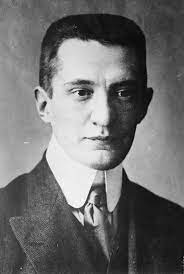
Quite a lengthy discussion of her lover, Kerensky, follows, something not really germane to the inquiry, except for the fact that Philby and Kerensky, not surprisingly, disliked each other. She does disclose that she disagreed with Kerensky, who, from London and Paris, was still hopeful of installing a liberal regime in Russia – and that may have been the cause of the reference to the ‘White Russian community in the U.K.’, which Rothschild noted. But that topic never comes up in the transcript. (As an aside, in a recent book review in the Spectator, Nigel Jones wrote that Kerensky ‘was a well-meaning drama queen who made the double mistake of continuing a hopeless war with a mutinous army and not shooting Lenin when the Bolshevik leader returned with the seductive slogan: “Peace, Land and Bread”’.)
Flora then returned to Philby’s ‘danger’, which she could not explain, adding that, at that point, she realized that the relationship between him and Litzi was a ‘completely business relationship’. Suddenly, she shifts to 1939, and asks Martin for confirmation that Philby went to France. She then says: “And the next I remember, Kim being one of the first people who came back after Dunkirk. And he came and stayed at my house, that I remember.” Only then does she describe the fall-out that occurred because of the Nazi-Soviet pact, when Kim ‘began to see me not as a friend any more’. Nevertheless, she places her introduction of Kim to Aileen in this period (summer 1940), stating that Neil Furse had convinced her to hire Aileen ‘at the time of the phoney war’ (i.e. after September 1939). Kim and Aileen fell in love: Flora warned Kim about Aileen’s neuroticism; she also told him that he had to get a divorce from Litzi, at which Kim said he couldn’t divorce Litzi because of her refugee status.
What is absurd about this farrago is the total amnesia over the events of September 3, 1939, when Aileen met Kim at a lunch arranged by Flora, attended by not only Eric Strauss, but also Frank Birch, after which Birch interviewed Philby for a job at GCHQ.
Flora, undaunted, then switches the subject to Litzi, indicating that she was on much closer terms with her than intimated elsewhere: “Well, Litzi knew that I knew the history, but it was never discussed between us, everything was assumed . . .” When Martin presses her, she admits that Litzi knew that Kim had confided in her, and Litzi spoke to her as if she were in the picture completely. Furthermore, Litzi and Kim were totally committed professionally (not that that should have come as a surprise to Martin and Rothschild). Flora then trips up when returning to the cohabitation of Kim and Aileen: ‘they met in ’39, no when was Dunkirk ’40, ’40 and they lived together, and they had a home’. Only now does she introduce Frank Birch, and her claim that ‘it was through Frank Birch that Kim came into your work’, and blusters about her failure to inform Birch of Philby’s politics. Yet the moment passes without inquisition: Martin asks no questions about the timing, or to what position Birch facilitated Philby’s recruitment, merely observing that he thought it was Burgess who brought Kim in, without indicating whether it was the SOE or the MI6 appointment.
Thereafter Solomon rambles somewhat, hinting at her involvement with some SOE work at Baker Street. She then describes the time that Philby and Burgess shared her flat , thus indicating a more intimate friendship than had presumably been understood by her interrogator, that she assumed that they were working together, and how she threw Burgess out because of his drunkenness and his remarks about Jews. She then spends a lot of time talking about Aileen’s self-destructive disease and declares that ‘she eventually committed suicide’ (something she learned from Neil Furse, she later explained). She saw a lot of Philby during the war, but thought he did not trust her any more. At one stage, Flora asked him whether Aileen knew everything about him, and Philby replied, resentful that she had asked the question, that Aileen knew nothing.
When the Burgess/Maclean story broke, she saw Philby once, and he just looked at Flora ‘pathetically’. It was at this point that Neil Furse told her that he was going to inform somebody of the close relationship between Philby and Burgess, and asked Flora whether she would do the same. She declined, but believed that Neil went ahead. She next spends a lot of time justifying her silence and describing how the intervening eleven years have changed her perspective, and why Kim’s anti-Zionist articles provoked her so much. If she had been approached in 1951, she claimed, she would have spoken up – but not off her own bat.
Next she turns to Philby’s friends. She thought that Guy Burgess knew that Kim had confided in her. Martin then asked for more specifics on how Philby had invited her to join the cause: she replied that she had cut him off before he could even explain what activities she might have assisted with. She believed he was still committed to working for the Soviets, since, if he had changed his views, she thought he would have told her. So, when she asked him again: ‘Does Aileen know?’, instead of replying ‘there’s nothing to know’, he merely repeated his denial.

Lastly, she incriminates Tomás Harris, whom she instinctively thought was tied up in Philby’s work, because of their intimacy. Flora could not identify anyone higher up with whom Philby could have communicated, but believed that Harris was some kind of intermediary. She would not mention any names beyond Burgess and Harris: Martin brings up the name of Michael Stewart, and she murmurs recognition. He introduces Anthony Blunt, and she immediately confesses that she knew him very well, while denying that he could have been involved. Martin sensibly asks why not, since the friendship between Blunt and Philby was similar to that of Harris and Philby. She waffles. They return to Litzi, and Flora has a hard time explaining why she saw so much of her when she was so unsympathetic to her character and role. Towards the end of the war, Litzi apparently came to Flora to ask whether she could help in some way.
Martin picks up her confusion, observing:
Please, if you’re right in saying that they were partners, they were professional partners, then it seems to me more likely that Litzi could be the means of contact with the Russian Intelligence Service rather than Kim, I means she had her communist doctrine, she was an open Communist, there was never any doubt about that, and of course she was going backwards and forwards to Paris.
Flora has to acknowledge the possibility, but the conversation meekly drifts to Kim’s feeble reasoning for not divorcing Litzi. Flora thought it ‘absurd’. Martin asks her about Edith Suschitzky: she says the name rings a bell, but she doesn’t know her. The conversation meanders again, retreading the ground about the telegram from Paris. Because of Kerensky’s futile hopes, she never believed that the Soviets would be seriously interested in her as an informant. She returns to Philby’s role in Spain, and her belated recognition that operating under cover was one of the pre-requisites of being an effective spy. Martin expresses total confusion about Philby’s joining the Anglo-German Friendship, stating that it happened in 1937-1938, ‘when he came back from Spain’. (Philby joined in January 1936.)
The quality of the exchange further deteriorates. They discuss Goronwy Rees, whom Flora knew vaguely. Martin points out that they have never discussed Donald Maclean: Flora says she never met him, and then turns the tables by interrogating Martin about the relationship between Burgess and Maclean. They wind up by observing how splendidly Philby had recovered from all the accusations about him. And then Martin asks a provocative question about Turkey, and whether Flora had heard anything in connection with Istanbul. Flora assumes that Martin is asking about Philby’s posting to Turkey, while Martin is presumably fishing about the Volkov incident. They come to a conclusion with a rather bizarre offer by Flora to determine what happened to Litzi, and a commitment by Martin to discover what it was that Neil Furse reported.
Arthur Martin’s Report
Martin’s report is dated August 8. It comes across as a competent executive summary, pressing all the right buttons, except for the fact that it glosses over all the inconsistencies and anomalies in Flora Solomon’s testimony. Any serious intelligence officer who had done his or her homework thoroughly, and studied the transcript in detail, would have raised a number of red flags. Martin introduces his subject by writing, rather equivocally:
Mrs. SOLOMON is an intelligent, flamboyant woman, quite capable I would judge of lying convincingly. Although I believe that she may have withheld some information from me, I do not think she lied.
Why Martin believed himself to be an exception to the deceptions that Flora was perceived to be capable of was not explained.
The compilation is lazy. Martin writes that Flora first met Philby as an adult when he returned from Vienna with Lizy [sic] – her on-the-fly correction. He describes Kim’s intervention in the release of an International Brigadier from Franco’s prison, Philby already in Spain accredited to Franco’s side: there is no comment on the claim made by Stevenson that Solomon had arranged Philby’s mission to Spain [“According to Aileen, before the war Flora sent Kim on a mission to Spain to contact a communist who was in trouble with the Falangists.”- above]. Philby’s return from Spain, where he had the fateful meal with Flora, is given as ‘probably 1938’. The Kerensky business is covered reliably, and Martin describes Solomon’s disillusionment on the announcement of the Nazi/Soviet Pact, at which point their sympathies diverged.
This is followed by the appalling laxity in not checking the timing of the first Aileen-Kim meeting: “In 1940 Kim met Aileen FURSE at her house.” Solomon warned Kim about Aileen’s neuroticism: Martin then jumps to ‘perhaps 1943’, when Flora asked Kim whether Aileen knew of his activities, and Kim assured her that she did not, Flora concluding from this statement that Kim was still heavily committed to working for the Russians. The reason that I judge these observations with such disdain is the evidence provided by the important memorandum that I cited in an earlier post ( https://coldspur.com/kim-philby-always-working-for-sis/ ), where the September 3, 1939 lunch attended by Philby, Strauss, Solomon, Birch and Aileen is described – see Figure below.
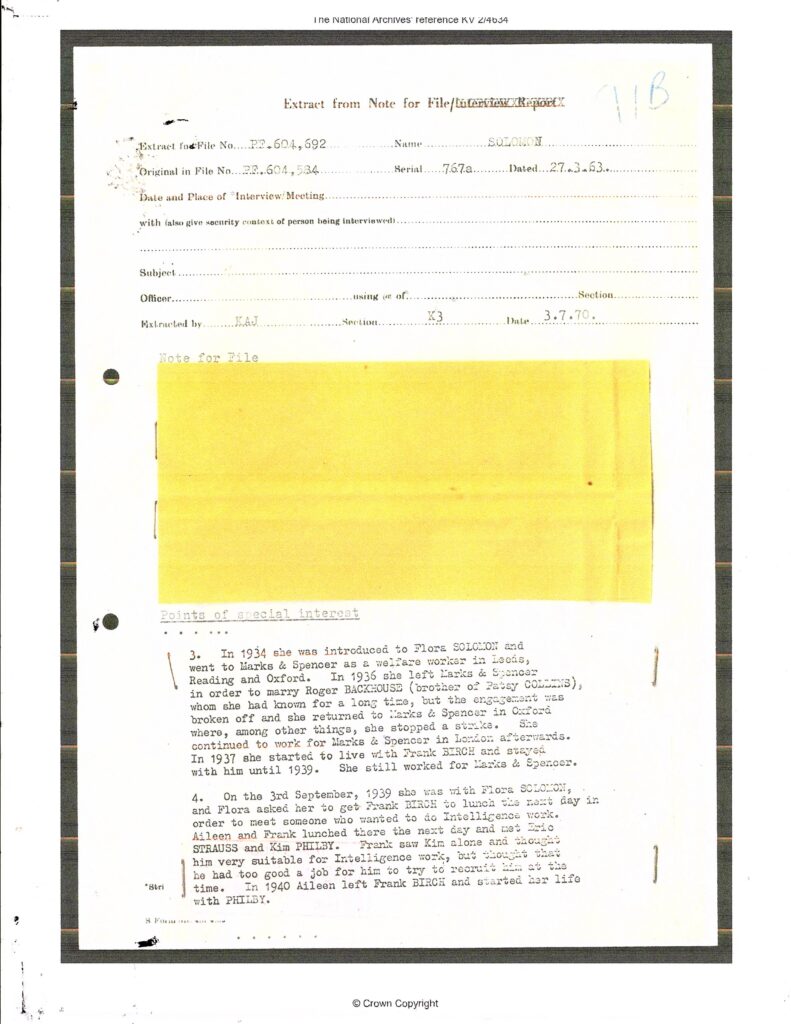
It is clear that this Note has been copied from the Philby file to the Solomon file on March 27, 1963, i.e. after Elliott has visited Philby in Beirut, and Philby has debunked to Moscow. Yet the memorandum must have been created much earlier. Since it describes activities of Aileen (‘she was introduced’, ‘she was with’), it must have been created in response to evidence provided by Aileen herself – or possibly by her psychiatrist, Eric Strauss, although it is unlikely that she would have confided such facts from several years ago to Strauss. But Aileen died in 1957, followed by Strauss in 1961. The incontrovertible conclusion is that Aileen was feeding MI5 information in the years between 1951 and 1957, and that this intelligence was stored in the shared ‘PHILBY’ file. (Note that the serial number of the entry in the PHILBY file, PF 604,584, is the very high number of 767a, indicating the bulkiness of the file.) Surely Martin must have had access to this file, and what he discovered would have immediately indicated that Flora’s evidence was a pack of lies: why did he not exploit it? Is it conceivable that its existence was concealed from Martin by his superior officers? (The paragraph I cite below concerning Aileen suggests that Martin knew more than he indicated, but that she was instructed to conceal the information.)
We have other indications that Aileen was passing on her suspicions about her husband to the authorities. I had earlier indicated how Aileen was unwittingly channeling her concerns and problems through her psychiatrist to the Security Service, but this excerpt represents stronger evidence that she was speaking to MI5 directly. The inscrutable and irresponsible Christopher Andrew, again relying on identified Security Service files, wrote:
There is other evidence [what?] that Aileen had finally realized her husband’s treachery and this had become a potential threat to him. One of her friends [who?] later claimed that she heard her blurt out one evening to Kim, ‘I know you’re the Third Man!’ That realization, combined with Kim’s mental cruelty, accelerated her decline into alcoholism and despair.
We know, from Rothschild’s testimony, that Aileen’s cousin Neil had contacted the War Office. It would not be surprising if Neil advised Aileen to make a similar direct approach to MI5. The very brief paragraph in Martin’s report includes the following provocative sentence: “Although I probed, she made no reference to statements about Kim which Aileen is known to have made xxxxxxxxxxxxxxxxxxxxxxxxx [redacted].”
Andrew also commented on Aileen’s death:
After her death, her psychiatrist said ‘that he had suspected that Aileen might have been murdered’ by Philby. That is highly unlikely – not least because by then Philby had moved to Beirut to work as a journalist.
Of course, Philby was not considered as the agent of death himself, but he might have requested the services of the KGB to perform the dirty work for him.
After confronting the stupidity or disingenuousness of MI5 over the Martin report, I found it hard to take seriously the remainder of what the hapless officer wrote. He skims over Litzi and Aileen, then mentions Burgess and his approach to her to help a colleague get a job with Gestetner. He records her suspicions about Tomás Harris, and her vagueness about when she first met him. He makes a brief reference to Frank Birch, stating that he was Aileen’s lover before Kim appeared, and reproduces without comment or challenge that Birch had been responsible for getting Philby his job in British Intelligence, without identifying the date or the position. He describes how Solomon declined to join Neil Furse in informing the authorities of the close friendship of Burgess and Philby. He closes by echoing the main reason Solomon gave for wanting to unmask Philby – his role as a Soviet propagandist against Israel.
It is difficult to see the point of this mess. As a deposition to intensify the fact of Philby’s guilt it is so unworldly and full of holes that a coach-and-horses could have been drawn through it. If MI5 (and MI6) intended to use its findings as a way of convincing Philby that they had proof of his espionage, he would have laughed in their faces. When he was under attack in November 1955 as being he ‘Third Man’, Philby rejected the accusation by declaring that the idea of a ‘Third Man’ was completely hypothetical. He could then have pointed out that, since he was in Washington at the time, it would have been impossible for him to engineer the escape. Similarly, if confronted with the ‘fact’ that he had tried to recruit Solomon at an unknown date in 1938, he could have pointed out that he was in Spain at the time, identified the other untruths in her story, and dismissed the allegations as the ravings of a deranged woman.
The Aftermath
What happened thereafter is all very tame. The telephone and mail checks were quickly cancelled, as they revealed nothing – as had the checks imposed on her back in 1953, when Stevenson made his verbal assault on her. On October 17, 1962, Martin wrote a summary of the Flora Solomon case for his boss, noting that ‘We are busy preparing a re-assessment of the PEACH case which I will let you have as soon as it is ready.’ This summary is bland in the extreme, reproducing Stevenson’s accusations as the main plank in the argument, while also listing what Flora told Lord Rothschild. How this paper could have contributed to a ‘re-assessment of PEACH’, given what information MI5 already held on Philby, is hard to imagine. Peter Wright wrote that ‘McBarnet drew up a voluminous brief in preparation for the confrontation’: it is not clear whether Elliott was given this to read before he set out, at short notice, in Martin’s stead, to challenge Philby. A copy of the brief presumably lies in the Philby file.
The archive is silent for a few months, until an awkward memorandum appears, dated February 26, 1963, written by Evelyn McBarnet. She is asking for the telephone check on Flora to be renewed, since ‘Mrs. SOLOMON is known to have been a contact of H.A.R. PHILBY, and we are anxious to know her reactions to the news of his disappearance.’ Elliott had arrived in Beirut on January 10, 1963, and had met Philby two days later. Philby had temporized and given a partial confession. On January 23 he absconded.
The unmasking of Philby was probably enabled primarily by the defection of Anatoli Golitysn in December 1961. (In Agent Sniper, Tim Tate writes, using CIA archives, about defector Michał Goleniewski’s claims concerning Philby. After Philby’s escape Goleniewski wrote that he had, over a period of two years, provided hints to MI6 about him, but had been rebuffed because of supposed flaws in his intelligence.) In the spring of 1962, Golitsyn visited London and pointed to the Cambridge ‘Ring of Five’. Christopher Andrew, in an Endnote, remarks:
Golitsyn did indeed possess intelligence, whose importance he exaggerated, about the Cambridge ‘Ring of Five’; though Philby did not realize it, he did not have information which clearly identified Philby as a member of it.
Yet it would not have taken much imagination on the part of the occasionally sluggish officers in MI5 to conclude, given the dossier they had on Philby, that, if such a pentad existed, Philby was by far the most obvious candidate for one of the remaining three. (Nigel West writes that Philby’s identity as STANLEY in the VENONA transcripts was not discovered until after he had defected.) Suggesting that, on the contrary, MI5 became distracted by alarms from the Soviet defector, Andrew supplies in his text the following insight (again exploiting one of those unidentified Security Service archives):
The defection of a KGB major, Anatoli Golitsyn, to the CIA in December 1961, both provided significant new intelligence on the Five and sent the Service investigation as a whole seriously off course [i.e. on mole-hunting within MI5]
Furthermore, he quotes a memorandum sent by Furnival Jones to the Home Secretary in 1966 that expressed concern that the network of five had expanded beyond that number, and thus infiltrated the Service.
Yet Andrew then appears to go off the rails, ascribing the Solomon revelations as the ‘breakthrough’ in the ‘prolonged and generally dispiriting Security Service investigation of the Philby case’. Echoing Solomon’s story that Philby had tried to recruit her before the war, Andrew bizarrely uses as his source Kenneth Rose’s 2003 biography Elusive Rothschild (ignoring, or being ignorant of, Solomon’s 1984 memoir: his Index contains no entry for her) instead of exploiting any part of the Solomon archive. (Perhaps his minders decided that it would be best if such files were concealed from him.) Andrew then offers the dramatic conclusion:
Armed with Solomon’s information, Philby’s friend and former SIS colleague Nicholas Elliott flew out from London at the beginning of 1963 to confront him in Beirut, where he was working as a journalist.
While grossly exaggerating the quality of the Solomon testimony, Andrew finesses the whole episode where Elliott (who had been Philby’s stoutest defender) was chosen as a late replacement for Martin. The hypothesis that Dick White, now head of MI6, engineered Philby’s escape through the offices of Anthony Blunt is perhaps better left until another day, but it is useful to record here White’s account of the proceedings. White was firmly convinced of Philby’s guilt, and he was persuaded even more so by Golitsyn’s evidence. He appeared not to consider the Solomon revelations as a breakthrough, and instead created an imaginary KGB informant to help convince Nicholas Elliott that Philby had been, and still was, a Soviet agent. White’s agreed strategy with Prime Minster MacMillan was to offer Philby immunity in exchange for a ‘full’ confession, but he surely must have known that that could have been a hollow, one-sided affair, and, after all, what would have happened to Philby after the deal was done?
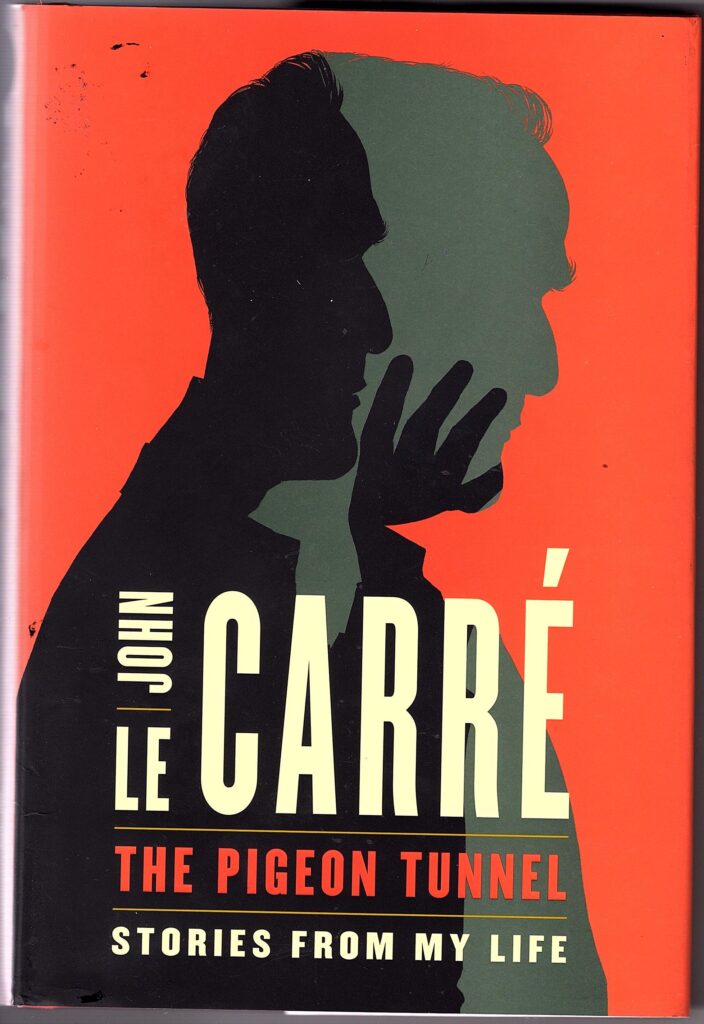
Elliott’s role in the adventure is uncertain: the reading public relies solely on him for the record of what he and Philby discussed in Beirut, and his claims could be utterly false. In the conclusion presented by le Carré in his version of the Elliott interviews, words that do not appear in Macintyre’s Afterword, appear the following sentences:
Whether by then he [Elliott] was under orders to give Philby the space to obtain a confession, we’ll probably never know for sure. Whether he was or not, he fooled me, just as he was fooling himself.
The problem is that Elliott never offers a convincing explanation of why he was suddenly convinced of Philby’s guilt, and he is deceptive over the circumstances, and his description is impossibly incongruous. In 1962, he had been head of station in Beirut, and told le Carré that he received a cable from Dick White saying ‘they had the proof’, that White wanted him to go and confront him, and that Elliott then ‘flew to Beirut’, without any questioning of the evidence, or request for a personal briefing for what would have been a very delicate operation. (From where did he fly, might one ask? Yet le Carré did not challenge him). Macintyre then reports that Elliott, having been offered a promotion in October 1962, with responsibility for Africa, had returned to London from Beirut, and was at that stage told the news by White in person – a far likelier scenario.
Lastly, Elliott gives a very idiosyncratic and provocative account of his dealings with Strauss. He told le Carré:
So I went and saw him and he told me Philby was homosexual. Never mind all his philandering, never mind that Aileen, whom I knew pretty well, said Philby liked his sex and was pretty good at it. He was homosexual, all part of a syndrome, and the psychiatrist, on no evidence he knew of, was also convinced he was bad. Working for the Russians. Or something. He couldn’t be precise but he was sure of it. He advised me to look for a mother figure. Somewhere there’ll be a mother figure, he said. It was this woman Solomon. [Flora Solomon who introduced Philby to Aileen in 1939.] Jewish woman. She was working in Marks and Spencer’s, a buyer or something. She was angry with Philby over the Jewish thing. Philby had been working for Colonel Teague, who was Head of Station in Jerusalem, and Teague was anti-Jewish, and she was angry. So she told us some things about him. Five (MI5) were in charge by then, and I passed it all on to Five – get the mother figure, Solomon. Wouldn’t listen of course, they’re too bureaucratic.’
I find most of this preposterous. One would expect a sexologist (and a homosexual at that) to know the difference between a homosexual and a bisexual – if, indeed, Philby could be placed in that latter category. (The evidence is flimsy, and Philby was a dedicated chaser of women.) Kim already had a quite capable and loved ‘mother figure’ – his own mother. Why Strauss would assert to him that Philby was ‘working for the Russians’, on no evidence, yet be sure of the fact, is inexplicable unless Aileen had discovered the truth, yet Elliott does not explicitly attribute that insight to Aileen. There is no evidence that Solomon went to MI6 (Rothschild was an ex-MI5 man, of course), and the notion that MI5 ignored Elliott’s hints is belied by what can be viewed in Solomon’s file. Moreover, Elliott never mentions the Arthur Martin business. Another unaccomplished dissembler, whose evidence should never be trusted.
To complete the coverage, I record that some further fascinating items from the 1960s can be seen in the Solomon archive – including the transcription of interviews between Martin, Peter Wright and Anthony Blunt dated February 5 and February 19, 1965. A long note from Wright, dated December 5, 1966, records another attempt to interview Solomon, who declared that she ‘did not like Arthur Martin and was fed up with Victor Rothschild’. She appeared to be concerned about her safety, perturbed about the incompletely explained death of Tomás Harris. She complained about Moura Budberg, who had in her cups one evening confessed that she had worked both for the Foreign Office and the Russians. Peter Wright’s account of these episodes runs as follows:
The most important help Victor gave me was persuading Flora Solomon to meet MI5 again. I knew from her session with Arthur that she knew far more than she was saying. She had obviously been in the thick of things in the mid-1930s, part inspiration, part fellow accomplice, and part courier for the fledgling Ring of Five along with her friends Litzi Philby and Edith Tudor Hart. After her meeting with Arthur she refused to meet MI5 again. She had a typically Russian paranoia about conspiracy and treachery. She was convinced we would double-cross her, and put her in prison. Or that she would be assassinated by the Russians, as she believed had happened to Tomas Harris.
When he did, despite her protestations, gain his interview, Wright’s introduction of new names to her (Dennis Proctor and Alister Watson) shed some further revelations, but this topic should likewise be left for another day. Instead, I move on to the third of the physical files, concerning Peter Wright and Golitsyn, and the investigation by Stella Rimington.
Anatoly Golitsyn
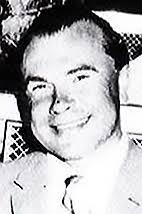
In November 1969 Peter Wright had a further interview with Anatoly Golitsyn, codenamed KAGO. By this time, Golitsyn’s reputation had been tarnished: his initial claims about penetration agents had been correct, but vague, and he was by now promoting conspiracy theories about deeper infiltration of Britain’s intelligence services. Arthur Martin was one who had become enthused about what Golitsyn said. In Defend the Realm, Christopher Andrew offered an equivocal summarization of Martin:
Martin was a skilful and persistent counter-espionage investigator [shome mishtake, shurely?] who was awarded the CBE in 1963, but he lacked the capacity for balanced judgment and a grasp of the broader context. Director B, John Marriott, had written of him in 1955: ‘In spite of his undeniable critical and analytical gifts and powers of lucid expression on paper, I must confess that I am not convinced that he is not a rather small minded man, and I doubt he will much increase in stature as he grows older.
(Just the man for a gong, obviously.) Golitsyn’s knowledge ranged over a wide field, but lacked depth, according to Andrew, and, like most defectors, he was trying to justify his dinner-plate by keeping the pot boiling.
What Golitsyn wanted to know (wrote Wright) was how Philby had been tipped off in 1962, and Wright told him that MI5 and MI6 between them had noticed that Yuri Modin, Philby’s controller, had visited the Middle East in September 1962. Wright added that ‘we know from Mrs. Philby [i.e. the former Eleanor Brewer] that some time shortly after this PHILBY became very upset and began drinking heavily’. It was only at this stage that Golitsyn was told about the Flora Solomon episodes. Wright told Golitsyn that ‘it was her evidence together with KAGO’s that had clinched the case.’
Golitsyn then asked whether MI5 was sure that Flora was not under Russian control, casting doubt on her assertion that she had not agreed to work for Philby. At this juncture, matters became even murkier, since Wright, in an aside comment, wrote:
I did not tell KAGO, but one has to take into account the letter that BLUNT told us about which was amongst BURGESS’ books after Burgess went, which was a letter from PHILBY to BURGESS telling him that if ever he was in dire trouble he could take this letter to Flora SOLOMON who would help him. BLUNT claimed he destroyed this letter.
Wight appeared to accept this story, but it smells very phoney. Burgess and Solomon knew each other well. Why would he need a letter from Philby? Why would Burgess have to go to Solomon if he were in dire straits, and how would she help him in ways that his regular contact could not? Why would Philby entrust such a sensitive message to paper rather than simply telling Burgess? What other information did the letter contain? It sounds to me as if Blunt were trying to shift some blame somehow, or maybe appear to be fulfilling part of his agreement to give a full description of the extended Ring.
Wright questioned Golitsyn: why would the Russians want to shop Philby – that is, presumably, by using Solomon to betray him at this stage? Golitsyn’s subsequent logic is tortuous.
KAGO said that in his view the K.G.B. would have assessed that he [Golitsyn] had sufficient information to give us to enable us to prove the PHILBY case. If PHILBY knew, as undoubtedly he did, other important agents in the United Kingdom the K.G.B. would be anxious to withdraw PHILBY as soon as possible. KAGO asked was it possible that the K.G.B. had tried to persuade PHILBY to go to Russia and PHILBY had refused to go. PHILBY might well have argued with the K.G.B. that the evidence that KAGO had was not strong enough to be a real danger to him. The K.G.B. would not have believed this but would have been unable to have made PHILBY defect without further pressure. KAGO said was it possible that Flora SOLOMON had been briefed to pass on the story she did in order to ensure that we had the evidence to prove the PHILBY case.
For someone who apparently did not know of Flora Solomon’s existence until a few minutes beforehand, this could be viewed as a bold leap in the dark by Golitsyn. And the assessment seems to reflect an ignorance about how both MI5 and the KGB worked. The KGB was apparently under the impression that Philby would name names under torture – the method they would use. Yet Philby had survived severe interrogation already simply by denying everything. And the KGB did not rely on patient argument to achieve their results. If they considered Philby’s continued presence a real danger, they would either have ordered him to abscond, or simply disposed of him, just like Tomás Harris or any of the other victims they selected. And why would the KGB trust Solomon to tell the right story? She might herself give away far more than they planned, or, if MI5 were shrewd, the Security Service would pick up incongruities in her story. The idea that the confused and unreliable testimony of Solomon would somehow seal the deal strikes me as ludicrous.
All this heady theorizing was too much for Wright to process, and he let Golitsyn’s words pass without comment. Golitsyn had the last word in the memorandum:
KAGO went on to say that the implication of this theory was that the K.G.B. had sufficient penetration that they could control our action over PHILBY so that we would not recall him and arrest him but probably do what we in fact did do.
And what was it that they did? And did Golitsyn know what that was? The implication by Wright is that MI5/MI6 never had the objective of bringing Philby back to the UK, but perhaps planned instead to warn him and let him escape. Golitsyn implied that this strategy was masterminded by the Kremlin, as opposed to what Wright insinuates, that it was one devised by White, constituting the most advantageous escape-route, politically, for the intelligence services. Vairy interesting!
At this point, I venture to quote what Stella Rimington wrote about counter-espionage work, and Peter Wright’s suitability for the task (p 117 of Open Secret):
But it [counter-espionage work] is not the quick jumping to conclusions and the twisting of facts to meet the theory which Peter Wright went in for in those days. He was in fact by then [1972] everything which a counter-espionage officer should not be. He was self-important, he had an over-developed imagination and an obsessive personality which had turned into paranoia. And above all he was lazy.
The Rimington Investigation
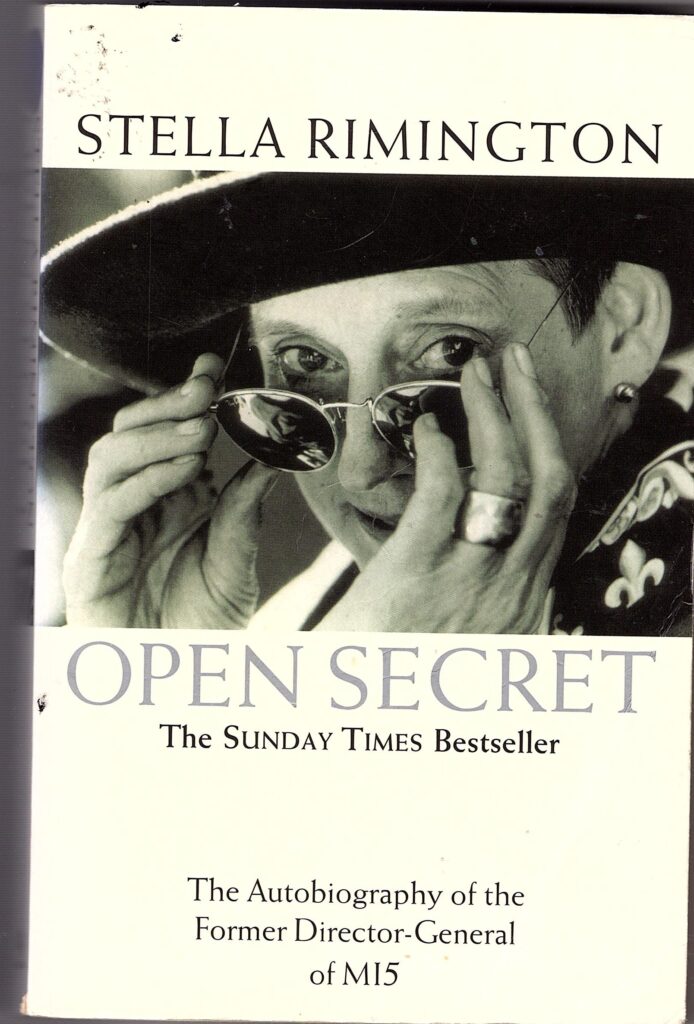
Stella Rimington (who was Director-General of MI5 between 1992 and 1996) never actually mentions Solomon’s name in her autobiography, Open Secret. That reticence appears unnecessarily coy, given the frankness with which she describes several of her exploits with the Security Service. She joined in 1969, and in 1973 was promoted to an officer, which meant that she ‘was allowed out to do interviews on my own’. She added:
. . . one of those interviewed at that period was a rather grand old lady, who had been the Head of Personnel in a large company, but was then retired. She had been a friend of the Philby family and had known since the beginning the important fact, which Philby had successfully disguised, that he had been a communist since the early 1930s.
Rimington goes on to explain that her superior officers believed that Solomon knew a lot more than she had admitted to Peter Wright, and Rimington was deputed to visit Solomon to try to determine whether she could reveal to them how Philby had been recruited. But Solomon was unresponsive, and ‘had Rimington on toast’, since the MI5 officer could offer no inducement to make her talk.
This anecdote shows that even the most outspoken of MI5 officers is prey to deception or distorted (or selective) memory. It was of course Arthur Martin not Peter Wright who carried out the interrogation. Moreover, Rimington, as a trainee, had been deputed in 1971 to write up a full analysis of the Solomon case. Her report, dated November 4, covers twenty-one pages. Why Rimington did not use any of the evidence she gathered in this exercise to challenge Solomon in 1974 is not clear.
The report contains much re-hashed material, as well as some useful new insights – and several redacted passages. Capturing the highlights does not lend itself to the creation of a fluent narrative, so I shall instead bulletinize the most illuminating observations:
- Her citing of the 1953 evidence (the ‘Stevenson’ material) is redacted to conceal the source.
- She explains that Solomon, when she approached Rothschild in July 1962, volunteered the information that she had known at the time of the Spanish Civil War that Philby was working for the Russians and had tried to recruit her – i.e. not the bland claim that Philby was simply a Communist.
- She claims that Solomon, in August 1962, when denying that she had ever been involved in espionage, refused to answer questions about anyone other than Philby. That was not true (e.g. Harris, Burgess).
- She notes that MI5’s file on Kerensky for 1933-1940 was destroyed.
- She echoes Solomon’s claim that she first met the adult Philby in either 1935 or 1936 without referring to the conflicting accounts that Solomon gave.
- She adds the intelligence gained from Solomon’s sister, Marie [Manya] Harari, that Philby swept Solomon off her feet after 1934, when her affair with Kerensky was fading. She writes: “According to Mrs. HARARI, Flora SOLOMON has an area of her mind of a vast and limitless stupidity which makes her liable to be used by dangerous people.”
- It appears that the Stevenson source had been reacted in the files, even for Rimington, since she expresses ignorance of the 1953 source who claimed that Solomon had become Philby’s mistress, and that ‘Aileen PHILBY had told his wife long ago that Flora SOLOMON was a Communist’. [This latter clause – appearing to introduce gratuitously the wife of ‘Stevenson’ – does not appear in the Solomon files.]
- She echoes the claim that Philby ‘as a journalist went backwards and forwards between Spain and England’. [I still await verification of such movements.] She repeats what Solomon said: that on one of these return visits, she asked Philby to intervene in the case of a relation of a friend of hers who had been imprisoned by Franco.
- In commenting on the period when Philby began to see a lot more of Solomon, she makes the illogical and incorrect statement that ‘She dates this as 1937 but it is more likely to have been 1938 as PHILBY was in England only between April and May 1937’. Philby was in Spain throughout 1938.
- She echoes Solomon’s claim that ‘after his assignment to Spain was over (she thought this was in 1938, after Munich) he rang her up in a state of great agitation’. [This was the assignation when Philby spoke of the danger he was in and tried to invoke Solomon’s support.] Philby did not return from Spain until July 1939.
- She relates the account that, in a conversation with her sister in 1966, Solomon said that she first suspected Philby when he received a medal from Franco. Rimington dates that event as happening in 1940: a hand-written correction indicates it was probably 1938.
- She notes that MI5 held no contemporary information on Solomon between 1937 and 1939, nor any comments from third parties that were relevant to that period.
- She confirms Solomon’s work with SOE during the war.
- She echoes Solomon’s claim that Philby visited her in her flat when he returned after Dunkirk. He brought friends to her flat, and Solomon described them as ‘vetting’ opportunities, designed to test their suitability for recruitment for intelligence purposes’. Rimington does not comment on the startling idea that Solomon was senior and experienced enough to execute such a role, especially if such candidates were being considered for British intelligence.
- She relates the appearance of Tomás Harris, whom Solomon believed was involved with Philby’s work for the Russians. She records that, in an interview in 1966, Solomon learned that Harris had been a courier and contact man for Philby in Spain. Anthony Blunt was a ‘great friend’.
- She is confused about the first meeting between Aileen and Kim. She records how Solomon had been responsible for introducing them, but does not date it, finessing the issue by hinting that they met only after Dunkirk, and soon started living together.
- She introduces the fact that Aileen had been living with Frank Birch before she met Kim, and that Philby went into intelligence work because of Birch’s assistance. Rimington appears to have ignored the documentation of the September 3 luncheon.
- She notes that, whereas Solomon claimed that she did not know Edith Tudor-Hart, in February 1971 Edith was able to identify a photograph of her. [Incidentally, Arthur Martin introduced her as ‘Edith Suschitzky’ in his first questioning of Solomon.]
- Only now does Rimington recognize the September 3, 1939 lunch, listing the attendees. She fails to address the conflicts. In a redacted comment on Eric Strauss, she notes that there was a report that he might have been a Communist as an undergraduate at Oxford. His sister was an open member of the CPGB.
- She records the episode of the letter that Blunt found in Burgess’s papers, where Blunt professed not to be able to remember the woman’s name. When prompted, Blunt claimed that he did not know Solomon well. Rimington fails to point out that that assertion contradicted how Solomon had described her relationship with Blunt.
- She describes Dudley Danby (private secretary to Lord Lloyd), who was surprised to see Philby at a Solomon party attended almost exclusively by Zionists.
- Item 29 is redacted completely, as are Items 31 and 32.
- Rimington volunteers the information that, in 1953, Aileen had been promised that Kim would be offered a job at Marks and Spencer, but after Flora Solomon was consulted, the offer was withdrawn.
- She echoes the Stevenson report claiming that Solomon was the mistress of Strauss: Stevenson’s identity is redacted.
- She provides the information that Yuri Modin travelled from USSR to Iraq in June 1962 and departed from Beirut to Vienna in August 1962. Rimington makes the rather lazy comment that ‘this visit of Modin’s to the Middle East was made at about the time when Flora Solomon first told her story to Lord Rothschild’, but it is clear that Modin’s tour could not have been prompted by the Solomon approach in Israel.
- Items 43 through 46 are redacted.
- Rimington introduces Phoebe Pool to the equation. Blunt reported in 1968 that Pool had told Willie Townsend not to go to Flora’s flat. (Pool, an acolyte of Blunt’s, would later commit suicide.)
- Rimington says that Solomon volunteered in 1967 that she thought that Danby had been a close friend of Philby’s in Beirut in 1962, and in 1969 she told Rothschild that she thought Danby was spying on behalf of Russia.
- She reproduces the discussion between Wright and Golitsyn without comment.
- She summarizes what is known about Solomon’s character (which is not flattering), but interprets it to suggest that her story is essentially true. She accepts Solomon’s story of helping Philby even though Flora had become disillusioned with the Soviet Union after 1939.
- She accepts the story that Golitsyn was the prime source of intelligence on Philby’s espionage, and that Philby was unwilling to leave when the Russians pressured him to do so. She swallows Golitsyn’s argument that Solomon’s evidence clinched the case against Philby. Yet she wonders why Solomon waited so long to denounce Philby.
- She accepts that the anti-Zionist reports submitted by Philby may have prompted her action, but does not consider why she did not approach the authorities in London, instead of waiting to go to Israel.
- She considers it very plausible that the Soviets would have chosen her as an agent for their purposes, but clumsily adds ‘it is not necessary to suppose that if what she did was convenient to the Russians she knew about it’. It is difficult to work out what Rimington means by this.
- She does at last draw out the conflict in Solomon’s and Blunt’s conflicting views of their friendship, and rightly questions the likelihood of Philby’s leaving such an incriminating message with Blunt. Her assessment here of Blunt’s possible motives is shrewd, but she does not regard the episode as sufficient reason to doubt Solomon’s story.
- She sums up by stating that Solomon’s story is ‘just about satisfactory, as ‘there is not a shred of evidence to disprove it’, a rather ingenuous conclusion.
- On the other hand, she points to all the ‘fishy’ aspects of her story that could point to illegal activities. On that basis, however, she sensibly opines that the Russians would have brought her to MI5’s attention in 1962.
- She believes that Solomon knows far more than she has told MI5 so far, but believes it will be difficult to extract anything else from her now.
Stella Rimington was identified as K3/8. As an addendum, it is worth recording that another trainee (presumably), B. Palliser, was designated K3/6, and in July 1971 undertook a detailed inspection of Philby’s articles in the Observer. He established that Philby’s name was appended to only four articles on the Middle East between October 1, 1961, and July 8, 1962, and they could hardly have been construed as being anti-Zionist. He adds a perceptive comment:
The statement of Flora SOLOMON which I quoted at 134a, that she said that PHILBY was ‘now writing violently anti-Israel articles and she believed that he was doing this on Russian instructions’ is taken from57a in Volume 1. 57a is a note by D [Furnival Jones] of 5th July, 1962, recording the handing over to the D.G. [Hollis] by C [White] of a note about a report made to Rothschild by Flora. The quoted statement appears, therefore, to be probably fourth-hand, from Flora to Lord ROTHSCHILD to C to the D.G. to D, and might have become slightly changed in its passage from one to the other.
Analysis of the Rimington Report

What was the purpose of Stella Rimington’s project – ‘Summary and Assessment of the Case of Flora Solomon’? Was it merely a training exercise, or did it constitute a serious re-appraisal of the evidence? I believe the former. It does not appear to have been sent to anyone higher than P.F. Stewart (K 3/0), who sends it on, with complimentary words, to someone identified as ‘K/Advisor’. Moreover, a typed comment at the head of the report runs: “This file summary does not necessarily include all significant information and should not be used as a substitute for study of the whole file if a comprehensive picture is required”. This suggests to me that Rimington was not given carte blanche to inspect the relevant records (i.e. surrounding files concerning Philby et al.), and probably was not allowed to inspect even the complete set of Solomon files themselves.
This is in fact evident from her selections and comments, where she shows a mixture of astonishing ignorance (e.g. concerning the inclusion of ‘Stevenson’, or the redacted passage that surely identifies him) to her total lack of appreciation of the role that Eric Strauss played in the affair. As I have shown, Christopher Andrew was shown this absolutely vital evidence, but it no doubt came from the Philby files, where information on Aileen’s and Kim’s activities were stored. On the other hand, Rimington occasionally introduces new material (e.g. the puzzling reference to the unidentified Stevenson’s wife). Since she does not include copies of the material that she had inspected, it is difficult to tell what selection she was guided to, or whether certain information was even redacted so that junior personnel – not to be trusted with such confidential information – were automatically protected from viewing such sensitive material. After all, Rimington was a trainee. If she failed the test, and had to return to the wide world, what might the exposure be?
Thus no one could be expected to offer a serious re-appraisal of the Solomon material without inspecting much more. And the dilettante aspect of the project is reinforced by the very casual way that the anomalies on Solomon’s testimony are treated. Rimington is very indulgent with the woman, as if she guessed that a report with that slant was what was expected of her. Thus she skates over the conflicts over the first meeting of the adult Philby, the dating of Aileen’s and Kim’s first encounter, the precise facts about Kim’s invitation to Flora at the lunch (or dinner), the period when Kim and Flora saw much more of each other, the depth of friendship between Blunt and Solomon, the implications of Birch’s interview, the incongruities of Modin’s and Solomon’s travel in the summer of 1962, the precise reasons why Solomon decided to speak up, etc. etc. She seems far too trusting of the capability of Solomon’s intervention to be the clinching argument in proving Philby’s guilt.
Thus it is difficult to conclude that anybody in MI5 was serious in wanting a proper re-evaluation of the case. For example, a full analysis of the Strauss disclosures would have been an essential component of such a study – but MI5 must have been mortally embarrassed that they had conducted such an exercise. And they failed to follow up in so many areas. Why was Frank Birch not interviewed before he died in 1956? He probably was, as he was investigated as a possible member of the extended Cambridge Group, but no record appears to have survived. In a 1998 essay, Christopher Andrew included him in a list of those who had been falsely accused of being Soviet spies, a rollcall that contained Peierls, Rothschild and Mann, but Andrew did not explain on what grounds he was able to absolve them all so confidently.
Did Birch in fact facilitate the entry of Flora Solomon’s son, Peter Benenson, into Bletchley Park? Why were Philby’s movements between Spain and England during the period 1937-1939 not investigated, to see whether his presence in London tallied with Solomon’s account? Why was ‘Stevenson’ not followed up, to determine what he had learned about Aileen, and how, and to verify the claim he made that Flora had somehow sent Philby on his mission to Spain? Why was Neil Furse’s approach to the War Office (acknowledged by Rothschild) not followed up and examined? Above all, the absence of any analysis of the complex relationships between Aileen, Kim, Strauss, Solomon, ‘Stevenson’ [Greene] and Birch is very telling. It all points to an acceptance that there were too many skeletons in the closet, and that they should not be disturbed.
In summary, the Rimington Report is an historical curiosity, released probably because of its author’s later prominence. While giving an opportunity for Rimington to show her analytical potential, it is an exercise in futility. It sheds no real fresh light on the Solomon case, merely confirming that MI5 wasted an enormous amount of time on counter-espionage charades. (I have searched for an email address for Dame Stella, in the hope of asking her what she recalled about the project, but in vain. Can anyone out there help?)
Conclusions
As with many of these cases, the fog has thickened fast. I offer my interpretation of the events.
- Solomon was a gossipy, attention-seeking, mendacious busybody. She was probably of no great danger to anyone but was well capable of causing trouble.
- Solomon was probably regarded by the KGB as an ‘agent of influence’ – someone who could help the Communist cause without being infiltrated into any sensitive position.
- If Solomon initiated the contact with Rothschild, she must have felt immune herself, and was thus probably not severely guilty.
- It is very unlikely that the KGB would have invoked Solomon in a project to encourage Philby to escape, for strategic, logistic and chronological reasons. It was out of character, and very risky: they had conventional means of disposing of irritants.
- Solomon’s approach was tardy and half-hearted, its motivation suspect. She could have acted in London if she had been serious. The approach to Rothschild seems very casual.
- If MI5 took her testimony seriously, they should have applied far more rigour to their analysis. The fact that they were so indulgent with Solomon’s lies and inconsistencies suggests that they did not regard it as a clincher.
- MI5 had enough evidence in their Philby dossier to confirm Philby’s guilt without any wild and belated claims from a rather unbalanced woman (as her sister described her).
- MI5’s intelligence on Philby had been sharpened by the information that Strauss gave them from his client consultations – a highly embarrassing project that MI5 failed to cover up.
- Golitsyn’s initial claims about the Cambridge Five (before he went off the rails) are far more likely to have been the trigger for confronting Philby.
- White was even more convinced of Philby’s guilt by Golitsyn’s testimony, but instead of using Solomon’s evidence invented a KGB source to convince Elliott.
- Nicholas Elliott was a proven liar, and any contributions he made to the story should be severely distrusted.
- The comments of Wright would tend to reinforce the theory that White viewed Philby’s escape as the least embarrassing endgame.
- White’s professed strategy was, however, feeble: giving Philby immunity in exchange for a ‘full’ confession. How would they know? (There is an exact analogy with the Blunt case.) What would happen to Philby afterwards?
- The shocking revelations made by Christopher Andrew about the information unethically passed on to MI5 by its informer, Eric Strauss, constitute a convincing reason why the files had to be so heavily redacted, both internally, and before release to the National Archives.
Lastly, consider the following outline for a screenplay:
It is 1953. A notable homosexual psychiatrist, who had been a member of the Communist Party at Oxford, has been persuaded by MI5 to divulge confidential information that his clients have told him. One of his private clients is a famous writer who used to work for Kim Philby. Another is Philby’s common-law wife, Aileen Furse, distraught over her husband’s mistreatment of her, and suspecting that he is the infamous ‘Third Man’ who in 1951 alerted Burgess and Maclean about the net closing in. Kim Philby’s closest friend in MI6, Nicholas Elliott later claimed that Strauss, with Aileen’s permission, had at this time revealed her suspicions about Philby to him. An intimate friend of the psychiatrist is a Russian Jew, Flora Solomon, who was a Communist herself, and is suspected by some in MI5 of being a Soviet spy. Philby was at one time emotionally attached to her, but she later claimed that they never had an affair. In turn, Aileen, a psychotic woman given to self-harm, had been infatuated with Ms. Solomon, who gave her a job after Aileen’s cousin, Neil Furse, who worked with Solomon, had recommended her to Flora. In September 1939, Solomon had also been responsible for bringing Philby and Aileen together, prompting Aileen to leave her current lover, Frank Birch, and live with Philby, who was in fact still married to his wife, Litzi, a Soviet agent. That same month, at Solomon’s instigation, Birch, who had taken up an important post at Bletchley Park when war broke out, interviewed Philby for a job in Intelligence, although Solomon never told Birch about Philby’s true allegiances. Solomon may also have used Birch to gain a position at Bletchley Park for her son. Now, in 1953, the famous writer, shocked at the discovery that the psychiatrist knows far more about Philby’s shady activities than he should, approaches MI5 to warn them of the leaks about his treachery. Unaware that Aileen shares his psychiatrist with him, the writer accuses Mrs. Solomon of exerting an evil influence on Philby, leading him astray, and passing on confidential information told her by Aileen. Aileen and her cousin Neil decide to approach the authorities directly about Philby’s close friendship with Guy Burgess, a supposedly vital clue that should help confirm Philby’s guilt.
Such a project would surely have been rejected as too far-fetched, but, if put in the hands of Alan Bennett or Tom Stoppard (or even Charlotte Philby) it would have made A Spy Among Friends look like Noddy Has An Adventure.
(This month’s Commonplace entries can be viewed here.)

